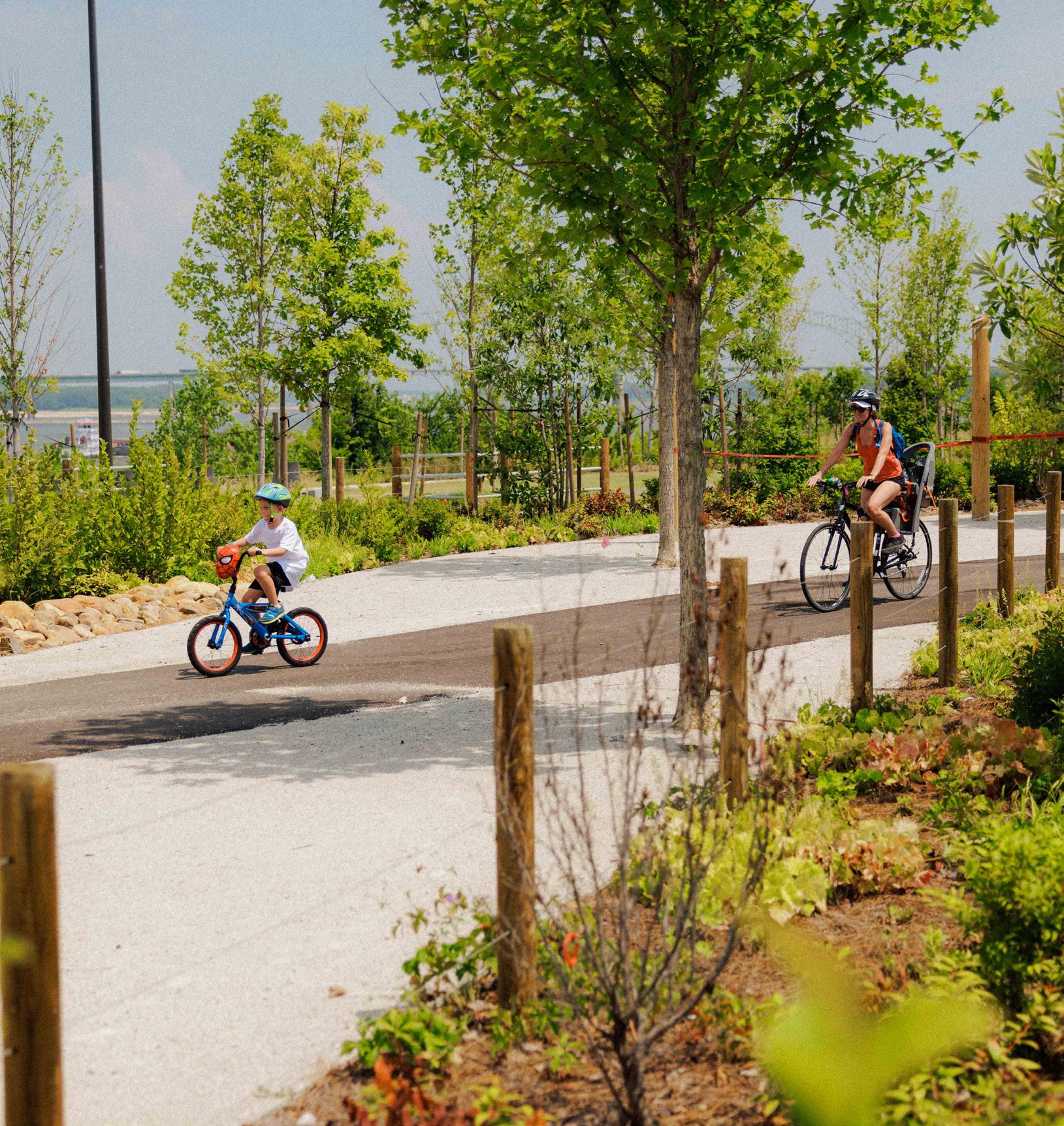

Environmental Sustainability
Reimagining the Civic Commons believes in the power of our shared public spaces to deliver social, economic and environmental benefits for more equitable and resilient communities. The four outcomes of Civic Engagement, Socioeconomic Mixing, Environmental Sustainability and Value Creation guide our approach to public space.
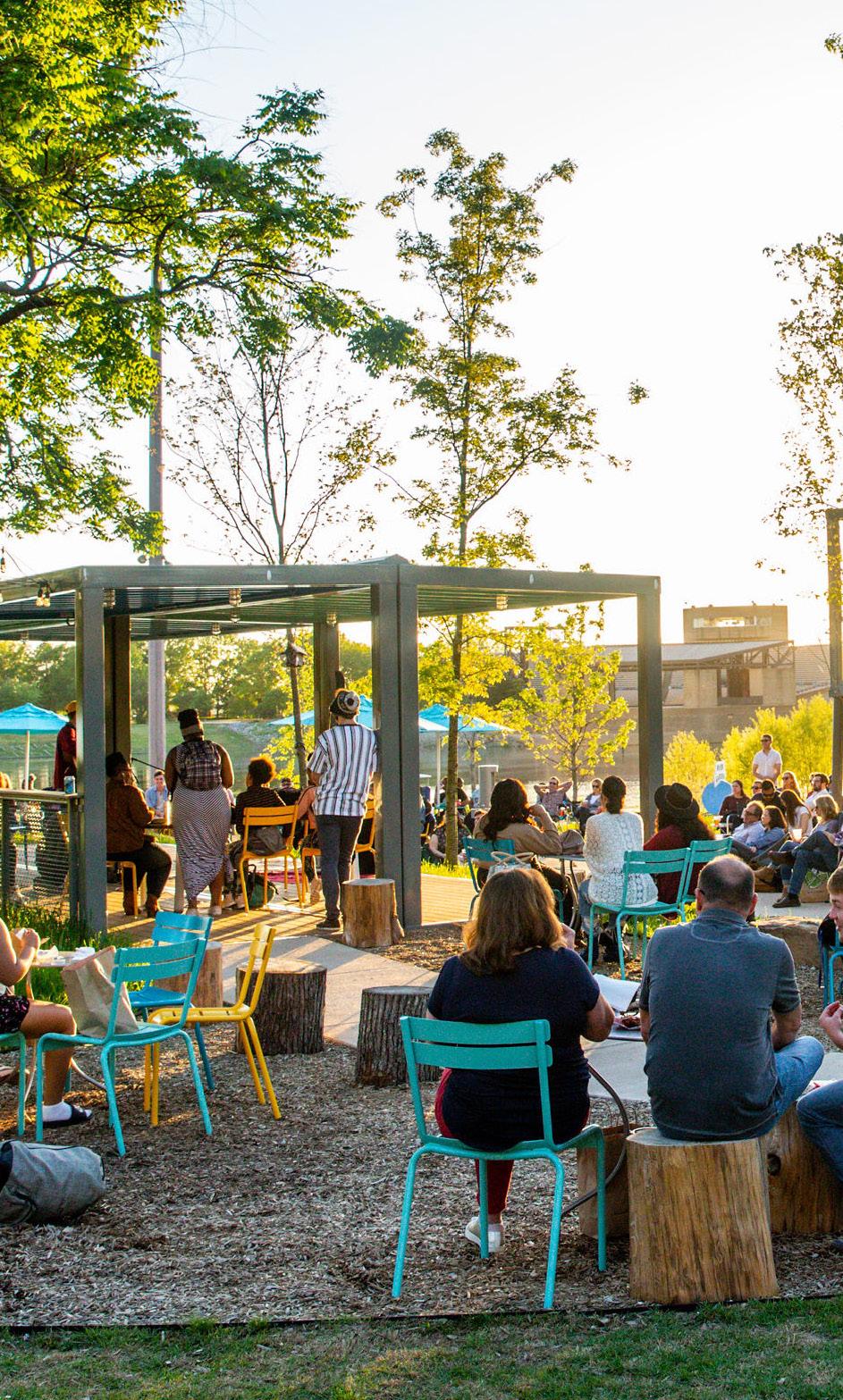
Environmental Sustainability Bringing Nature into Civic Life for Stronger, Healthier Communities
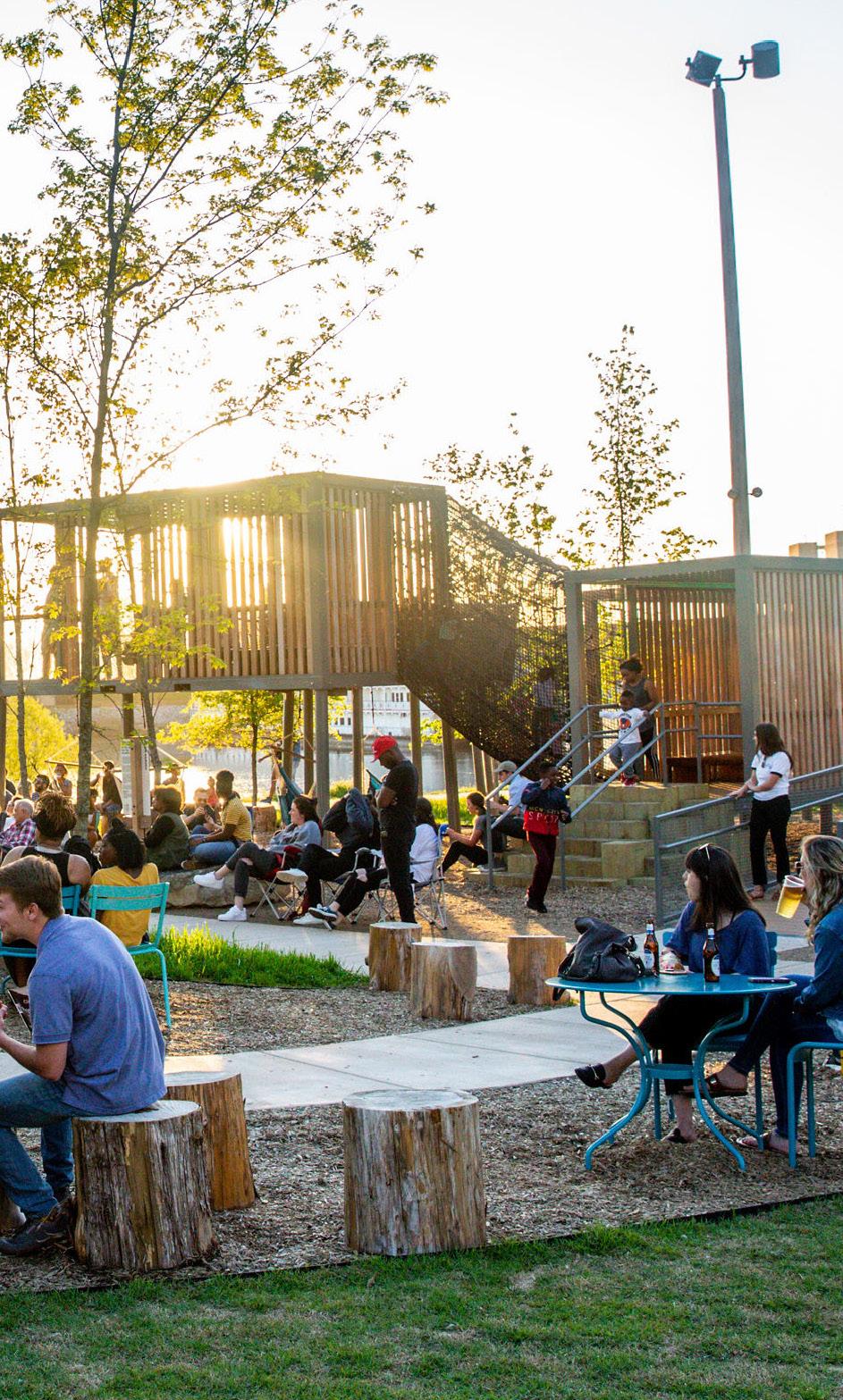
From Crisis to Commons
Across the country and around the world, the natural systems we rely on are under strain. Rising temperatures, more frequent and severe weather events and worsening air and water quality signal dangerous trends: our environment is becoming less livable, and our communities less resilient.
Climate change is a daily reality — especially in cities, where paved surfaces and concrete structures intensify heat, increase flood risk and degrade air quality. From the expanding urban heat island effect to flooding that overwhelms current infrastructure, the built environment is compounding the environmental risks residents face. These challenges do not affect everyone equally. Low-income neighborhoods and communities of color — often those with the fewest economic, environmental and civic resources — are hit hardest, bearing the brunt of environmental hazards without the protections or infrastructure needed to adapt. At the same time, cities are growing. More than half of the world’s population now lives in urban areas, and that number continues to rise. As urbanization accelerates, so do the pressures on land, water and air — and on the people who call these cities home.
While the climate crisis impacts our physical environment, it also amplifies the deepening disconnection between people and the natural world. In many urban communities, nature has been rendered inaccessible. For too many people — especially those living in neighborhoods facing current and historical disinvestment — the ability to access natural assets is rare or absent altogether.
As nature becomes less visible in our daily lives, so does our sense of care and responsibility for it. The loss is significant: reduced wellbeing, eroded environmental awareness and a weakening of the shared bonds that come from tending to a place together.
Environmental decline is not inevitable. There is an immense toolkit that cities can utilize to help mitigate the adverse impacts of climate change and promote a more sustainable future for their ecosystems and their residents, ranging from green infrastructure to urban planning and policy solutions to strengthening civic assets and encouraging social connection.
Our cities and communities can become places of adaptation and renewal. Public spaces are more than amenities — they are climate infrastructure. Civic assets such as parks, trails, libraries and community centers can play a vital role in reducing environmental harm, fostering health and connection and building resilience to the challenges ahead. If planned, designed and stewarded wisely, public spaces can be among our most powerful tools for a healthier, more resilient future.
What Is Environmental Sustainability?
Environmental sustainability means creating environments where people and nature can thrive together over the long term. More than conserving natural resources or reducing carbon footprints, it is about rebuilding a relationship between people and the ecosystems that support them.
Environmental sustainability is also intrinsic to our civic commons. Public spaces that prioritize green infrastructure and access to nature are not only climate solutions — they are tools for community building. They invite stewardship, create opportunities for shared experiences and foster the trust that is essential to resilient communities. Given that approximately onethird of a city’s land area is typically categorized as public space, our civic commons are indeed an essential opportunity to leverage for sustainability and climate resilience.
By focusing on the integration of nature into the civic commons, cities can meet the urgent demands of climate change while also enhancing the everyday lives of their residents. Climate-friendly design in public spaces is both a practical necessity and a tool for promoting equity in civic life — ensuring that all people, regardless of income or background, have access to healthy, vibrant and sustainable environments.
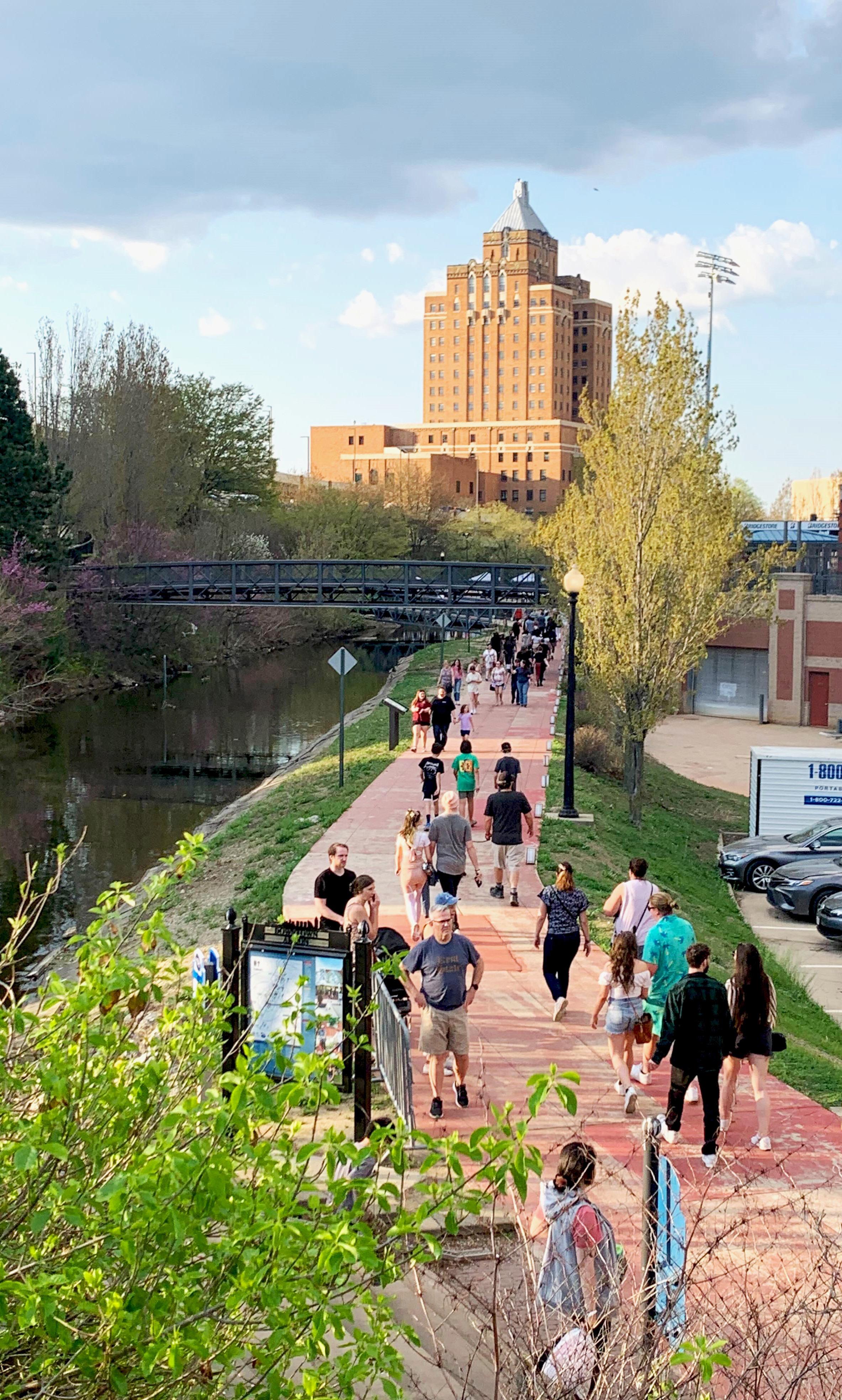
Why Environmental Sustainability Matters
The adverse effects of climate change are already shaping how we live. Heat-related deaths are on the rise, floods are more frequent and food insecurity is growing. City environments are particularly vulnerable to phenomena such as air pollution, extreme heat due to the urban heat island effect and often limited access to green spaces. The links between the environment and health are clear: cleaner air, cooler temperatures and proximity to green space all contribute to better physical and mental health outcomes. Research has found that health outcomes are deeply impacted by social conditions — so much so that they have a greater impact on our health than clinical care and genetics combined.
Given these growing challenges, it is increasingly clear that investing in green and accessible public spaces is not just an environmental strategy, but a critical public health intervention as well. Studies show that proximity to green space reduces the risk of premature death, extends life expectancy and improves our overall health. Permeable surfaces and trees reduce flooding and smog. Parks and trails promote physical activity and reduce stress. Furthermore, reductions in stress levels and depression have been linked to adequate access to public space and the increased greening of our communities. Nature can act as a buffer against the negative health effects of poverty and social isolation, showing the importance of pursuing interventions that improve and maintain green spaces as strategic public health solutions.
Beyond public health, social connection and civic engagement are also critical determinants of resilient cities. Communities with strong social ties are better equipped to prepare for, respond to and recover from environmental shocks. Supporting an active social environment can therefore support the sustainability of communities and promote environmental and public health equity for residents.
Public spaces foster these social connections. Civic assets such as parks, community centers and libraries provide platforms for gathering, volunteering and shared decision-making. These spaces are key social infrastructure that underpins a thriving civic life. Civic spaces double as strongholds for sustainability: proximity to tree canopy and green spaces not only reduces crime rates and increases civic participation, but provides necessary shading and air purification for urban communities. Open parks encourage recreational activity while improving the mental and physical health of communities. A neighborhood with tree-lined streets and safe walking paths isn’t just cooler and cleaner — it’s also more connected, engaged and resilient.
However, the burden of environmental harm on our physical environments, public health or social connectivity is not evenly distributed. People from low-income neighborhoods and communities of color are more likely to live near sources of pollution, have fewer trees and lack access to quality green space. These disparities are not accidental: they are the product of decades of disinvestment and exclusion.
The lowest-income neighborhoods in the U.S. have 26% less tree cover and can be as much as an average of 6°F hotter than wealthier areas. As green space becomes more desirable, some neighborhoods also experience displacement when environmental improvements lead to rising property values. When access to green space is directly linked to increased lifespan and positive public health benefits, the equitable distribution of sustainable practices and solutions is all the more critical.
To remedy entrenched socioeconomic health disparities, environmental sustainability must be pursued equitably. That means working with communities to ensure that investments improve local quality of life without triggering displacement, and that every resident has access to a clean, healthy and safe environment.
Why Now?
Environmental sustainability — especially when rooted in public space — can improve health, strengthen communities and build resilience. In today’s era of climate disruption and deepening inequality, the need for sustainable, equitable civic spaces is more urgent than ever.
Improved public health. Access to green space reduces premature death, lowers stress and improves physical and mental well-being. Trees and parks help cool neighborhoods, filter air and reduce flooding and pollution.
Resilience to shocks. Communities with strong social connections are better prepared to withstand climate shocks. Public spaces like parks, community centers and libraries support these connections by offering opportunities for gathering, volunteering and shared decision-making.
Safer, more engaged communities. Neighborhoods with more tree cover and green space experience less crime and higher civic participation. A shaded street or nearby park encourages walking, conversation and a sense of ownership in one’s community.
Equitable cities. Environmental sustainability rooted in the public realm fosters more equitable cities by ensuring that all residents have access to clean air, green space and climate-resilient infrastructure. When paired with opportunities for social connection, these shared spaces strengthen community bonds and empower collective action, creating more inclusive and just urban environments.
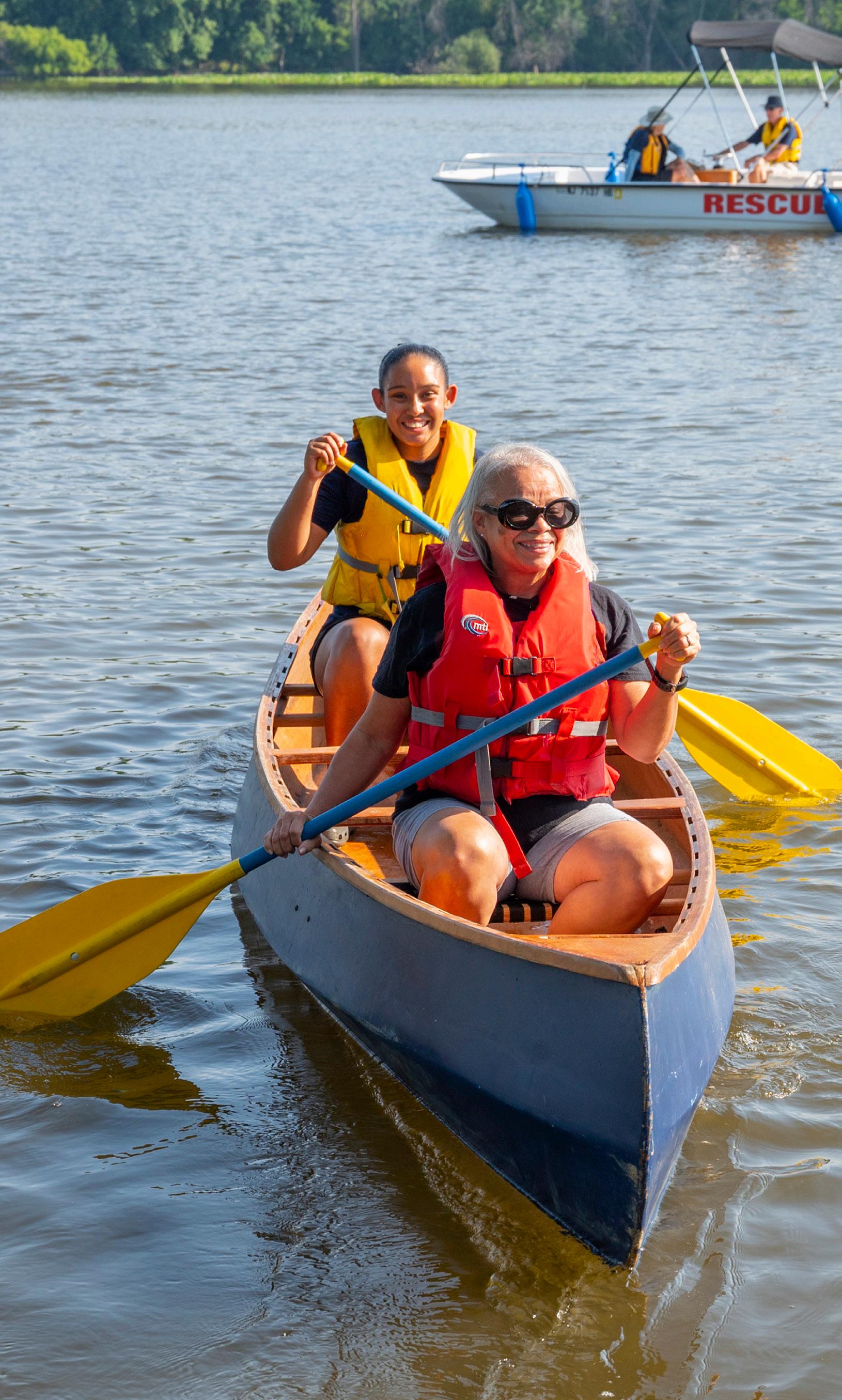
By designing and managing public spaces that advance environmental, social and health outcomes for every community, urban practitioners can effectively promote the long-term sustainability of their cities.
Reimagining Sustainability: A Toolkit for Cities
Environmental sustainability requires a holistic, multi-pronged approach that responds to the unique needs and assets of each community. Cities can draw on their existing resources to leverage cross-departmental tools and strategies to strengthen their sustainability and resiliency through their shared commons. Below are several recommendations for strategies and interventions that cities can draw from in the pursuit of healthy and vibrant communities.
Tree Canopy
A key strategy that cities can embrace to mitigate climate change effects is the expansion and maintenance of urban tree canopies, particularly in areas of historical disinvestment. There are numerous environmental benefits that trees provide, including significantly reducing surface and air temperatures, removing harmful pollutants from the air and absorbing stormwater runoff to prevent flooding. Planting trees is a fundamental tool for bolstering green spaces and their associated benefits for urban residents.
It is just as critical to maintain both existing and newly planted trees. Research shows that even in better-than-normal survivorship conditions, only 50% of trees planted in urban settings reach maturity (approximately 33 to 38 years of age); under average circumstances, 50% of trees only live to be 13 to 18 years old. Given that the bulk of climate- and health-related benefits are linked to mature trees, practitioners must prioritize the long-term maintenance of urban tree canopies.
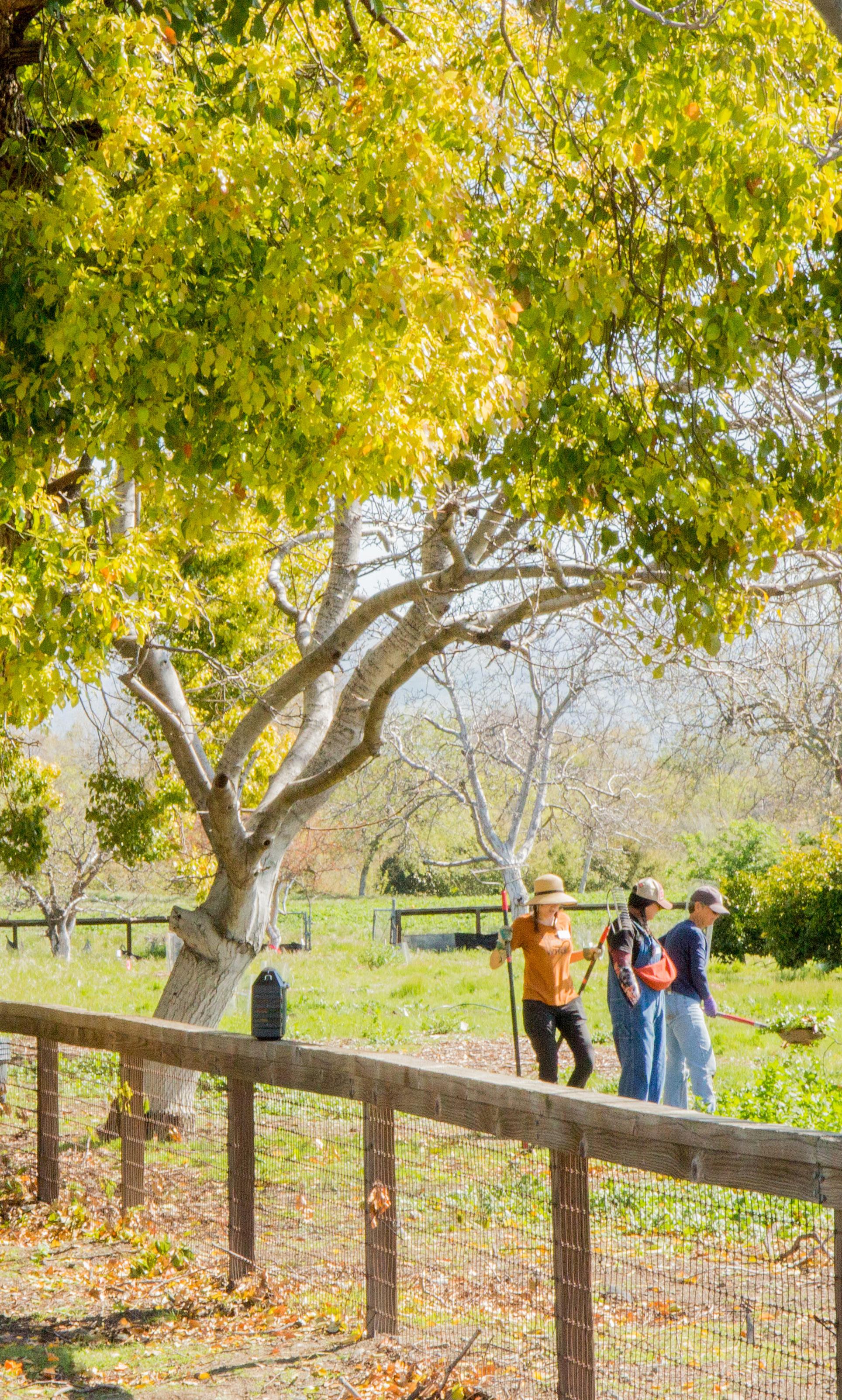
However, as the climate changes, the appropriate tree species for many communities are in flux. San José’s Guadalupe River Park has successfully navigated this challenge: its Historic Orchard has been nearly entirely replanted with more than 50 new tree and shrub species that better suit the region’s evolved climate. The orchard not only provides necessary tree cover, but acts as a place for education, community gathering and stewardship of green assets.
The benefits of tree canopy go far beyond the environment. Tree-lined streets are associated with higher levels of physical activity, stronger social ties and even lower crime rates. Tree-planting and stewardship initiatives, especially when designed with community input, can foster neighborhood pride and civic participation, creating shared ownership over the health of the local environment. With these crucial civic benefits, outdoor public spaces such as parks, trails, streetscapes and spaces adjacent to libraries and recreation centers become important opportunities for increasing tree canopy while positively promoting social connection.
Native Plant Materials
The use of native and adapted plants in public spaces offers wide-ranging environmental, economic and community benefits. Because native and adapted species are suited to local soils and climates, they require significantly less maintenance than conventional turf grass — meaning less mowing, lower water usage and no need for fertilizers or pesticides. This translates into long-term cost savings for cities.
Beyond their practicality, native and adapted plantings play a vital ecological role. They support biodiversity by providing essential habitat and food sources for pollinators, birds and other wildlife, helping to restore local ecosystems in urban areas where natural habitats are often fragmented or lost.
Programs like Fairmount Park Conservancy’s Mows to Meadows initiative in Philadelphia highlight the potential of this approach. By converting underutilized mowed lawns in the city’s public park system into native meadows, the program not only enhances biodiversity and environmental resilience, but also invites residents into the process — transforming overlooked spaces into community assets that foster stewardship and connection.
Green Stormwater Management
Many cities are leveraging green infrastructure as a critical strategy in mitigating stormwater management, particularly in the wake of heavier and more frequent rainfall and aging infrastructure across the nation. Green stormwater management — such as bioswales, rain gardens, green roofs and permeable pavement — help reduce runoff, replenish groundwater and filter pollutants before they reach rivers and lakes. These systems not only perform vital ecological functions but also offer opportunities for education, stewardship and beautification of public spaces. When integrated into parks, medians and plazas, they become visible symbols of resilience and community care.
The NE Siskiyou Green Street project in Portland transformed a quiet residential street into a widely-recognized streetscape model of sustainable civic infrastructure. By replacing sections of curbside parking with landscaped curb extensions, the project now manages nearly all of the street’s stormwater runoff — up to 225,000 gallons annually — through a natural system of native plants, soil and checkdams. As a partnership between the city and local residents, the project exemplifies how low-cost, communitysupported green infrastructure can improve environmental function while enhancing the character and resilience of the public realm.
Sustainable Building Materials
Choosing low-impact, recycled or non-toxic materials reduces greenhouse gas emissions and minimizes waste. Minimizing the use of concrete and cement also lessens the carbon dioxide impact from the production of those materials. The cement industry is responsibley for 7-8% of global CO2 pollution. Optimal materials include reclaimed wood, bamboo and recycled metal and glass. Another alternative building material is hempcrete, made of hemp fibers, lime and water. These sustainable materials all mitigate environmental impact and contribut to healthier, more energy-efficient and durable buildings. As cities continue to develop, committing to sustainable materials in the construction of public spaces offers a way for local governments to directly promote long-term environmental resiliency.
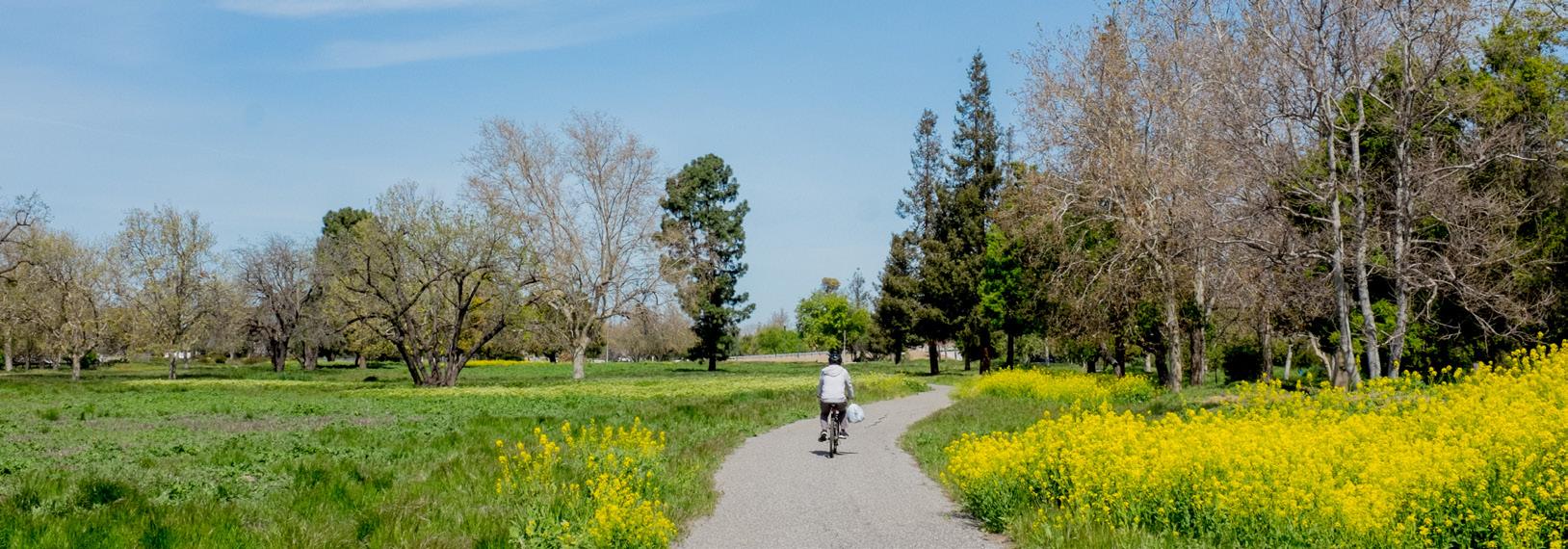
Cooling Design
Simple yet powerful, green roofs help cities combat the urban heat island effect by insulating buildings, absorbing rainwater and creating pockets of greenery in dense urban cores. Shade is also an important tool for beating the heat, but is often overlooked by cities as a tactic for environmental sustainability. Many urban neighborhoods lack shade in key public spaces like bus stops, playgrounds and trails. To address this gap and mitigate heat burden, cities can establish shade plans and implement shading structures such as trees, umbrellas or sails in the most vulnerable and frequented spaces. In particular, when installed on libraries, community centers and transit stops, green roofs and shade elements increase building efficiency and offer residents important respites from urban heat in key communal spaces.
Sustainable Performance in Construction and Development
Civic buildings and public spaces offer opportunities to showcase and demonstrate innovative sustainability performance standards. Leadership in Energy and Environmental Design (LEED) certification provides a globally-recognized benchmark for environmental performance, but many communities are going further. Other key rating systems to guide construction standards include WELL, SITES, Passive House, and the Living Building Challenge — all of which promote sustainable solutions throughout the design and development processes. The use of net-zero energy buildings, low-carbon construction and climate-positive design strategies are rapidly growing practices.
By thinking beyond private development and incorporating these metrics into public realm design, cities can literally pave a more sustainable future.
At Tom Lee Park in Memphis, for instance, earning SITES certification demonstrated a thoughtful, integrated strategy focused on restoring native vegetation, conserving water, using sustainable materials and building long-term resilience to benefit and safeguard nearby communities. These commitments enhance public health, reduce operating costs and demonstrate what’s possible when cities lead by example.
Social Connection as Resiliency
The spaces and places that help connect people, build trust and add vibrancy to cities play an important role in environmental resiliency. These assets, including community centers, libraries, neighborhood main streets, walking trails and parks, are key hubs in which social capital can be both built and maintained. Providing the basis for information sharing, inter-class and
inter-generational exchange and reciprocity between community members, this type of infrastructure is crucial for social connection.
Social connection by way of civic assets has been shown to improve community responsiveness, collaboration and adaptivity during times of crisis. For instance, studies show that during Japan’s 2011 earthquake and tsunami disaster, social infrastructure — the spaces and places that help build and maintain social ties and trust — was critical in mitigating and recovering from shocks, thus lowering mortality rates for vulnerable populations.
As natural disasters become increasingly frequent with our changing climate, investing in public space becomes all the more critical. A robust public realm must not only be built, it must be maintained and activated in ways that help promote connection and trust among diverse groups. Encouraging the development of these relationships through vibrant and active public spaces is a key tool in planning for environmental resiliency.
Sustainable Transportation Policy
Promoting transportation policy that encourages walking, biking and mass transit is essential to reducing emissions and building healthier, more connected communities. Prioritizing convenient connections to civic assets – such as parks, libraries, community centers and neighborhood main streets – with cleaner, more accessible modes through complete streets, greenways, trails and transit also supports public participation in these assets. These efforts not only help reduce carbon footprints but also strengthen the ties between residents and the civic commons, ensuring that public spaces and services remain accessible to all regardless of transit options. In this way, sustainable transportation policies not only serve the environment but also promote inclusivity, connectivity and the resilience of the communities they support.
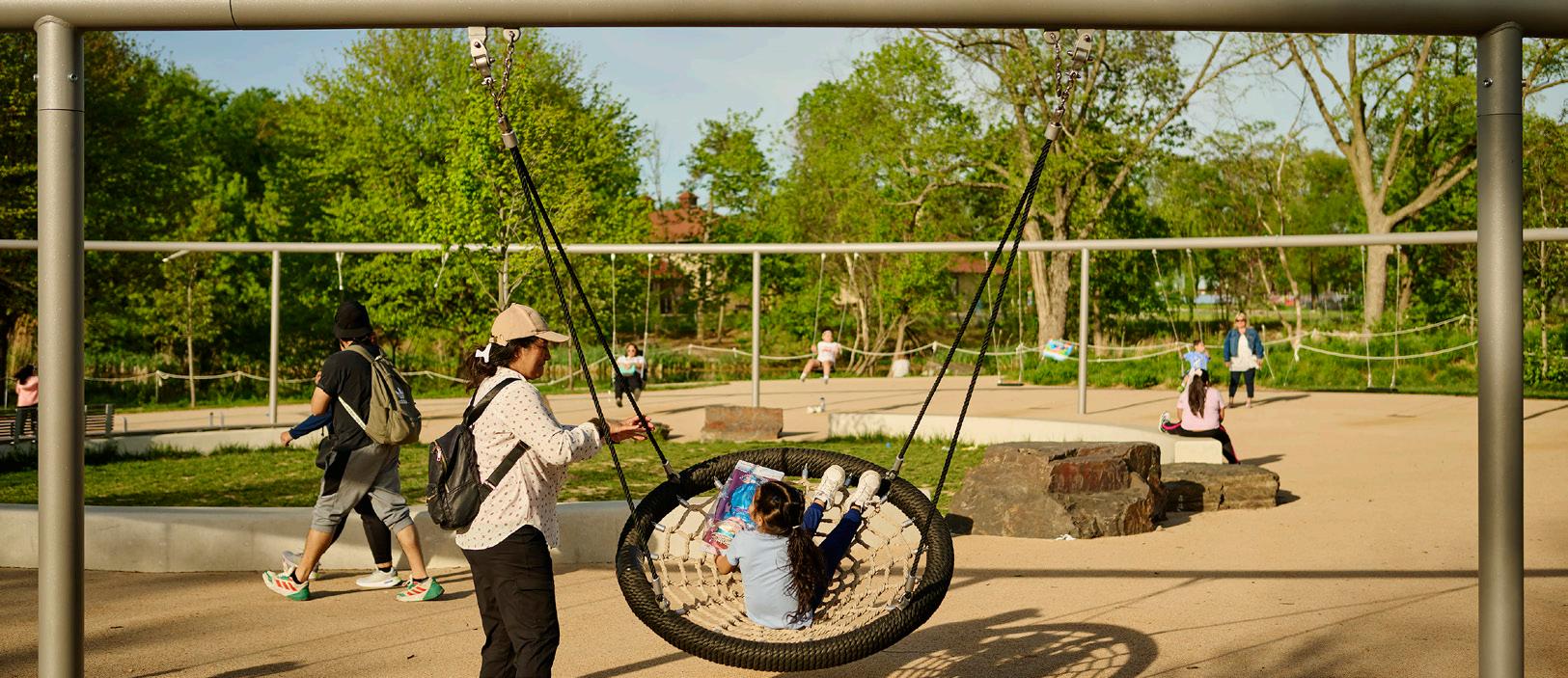
Trail-Oriented Development
Similar to transit-oriented development, trail-oriented development is an emerging model that centers active transportation — like walking and biking — as a catalyst for shaping communities that are healthier, more connected and environmentally resilient. By integrating trails into the fabric of urban design, trail-oriented development strengthens the role of public space as essential infrastructure, supports equitable access to green space and encourages development patterns that reduce car dependency. This approach advances long-term environmental sustainability by promoting alternative modes of mobility, reducing emissions, and reinforcing the ecological and social value of linear parks and trails.
Sustainable Zoning and Nature-Forward Policy Practices
Zoning and land use policies play a pivotal role in shaping how cities can grow in ways that support environmental sustainability, public life and social equity. Cities with zoning codes that encourage mixed-use development, reduce parking minimums and support green infrastructure can reduce sprawl and lower emissions from car-dependent development. Establishing urban growth boundaries helps protect natural landscapes and curb costly, resource-intensive expansion.
Beyond climate benefits, zoning changes have the potential to foster walkable, transit-accessible neighborhoods where public space is prioritized and everyday life unfolds more communally — on sidewalks, in plazas and within shared civic assets. These compact, connected neighborhoods use land and resources more efficiently and nurture social connection, health and resilience by making it easier for people to meet, gather and engage with one another. Forward-thinking zoning isn’t just about where we build — it’s about how we live together in a changing climate.
Supportive planning policy can also encourage non-natural assets like libraries and community centers to play a role in connecting people to nature. For example, Nature-Smart Libraries from the Children & Nature Network elevate how libraries are connecting people to nature through their programming, lending nature backpacks and recreational gear and partnering with nearby outdoor spaces. City budgets can allocate funding for these public places to intentionally implement more nature-related programs to connect residents to the natural world in their communities. Integrating nature-forward policies into both civic assets and city decision-making helps build environmental sustainability into all realms of public life.
Financial Tools for Green Infrastructure
Innovative funding mechanisms can accelerate sustainability goals. Financial tools such as green bonds allow cities to raise capital for infrastructure that delivers measurable ecological benefits. Climate budgeting incorporates sustainable goals into the annual city budgeting process and designates responsibility for implementation, monitoring, evaluation and reporting across various city departments. Public grants for urban forestry, stormwater retrofits or clean energy can unlock local innovation and reduce long-term costs. Cities can also better attract private funding for sustainable initiatives by ensuring clear, actionable project plans, strong governance systems and robust internal capacity for implementation. When paired with strong accountability and community engagement, these financial tools make sustainability both fiscally and politically feasible.
Financial tools such as these help to improve public spaces — planting trees, creating shaded walkways, revitalizing parks — and in doing so, foster shared environments that bring people together, reduce social isolation and enhance quality of life. Financial tools are not just enablers of sustainability — they’re vehicles for equitable, place-based investment in the civic commons.
Public spaces are platforms for possibility. When designed and managed with intention, they can promote environmental resilience, build community and support the health and well-being of all residents. At every level of decision-making related to the public realm, there are valuable opportunities to increase environmental sustainability.
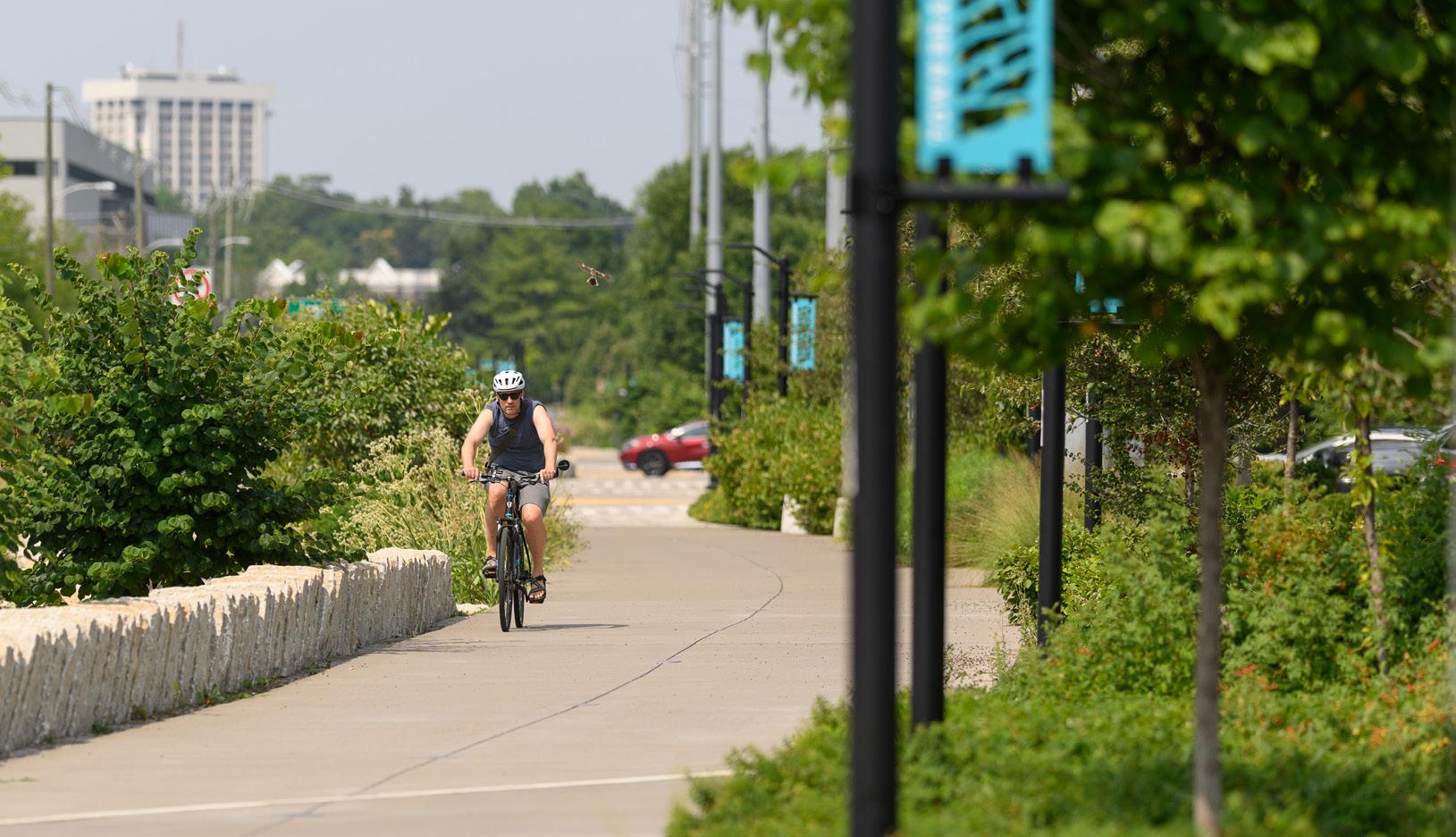
Environmental Sustainability in Action
Sustainable public spaces are vital to civic life. When designed with intention, these spaces not only address environmental challenges — they bring people together, foster connection and build trust. In doing so, they strengthen both community and ecological resilience.
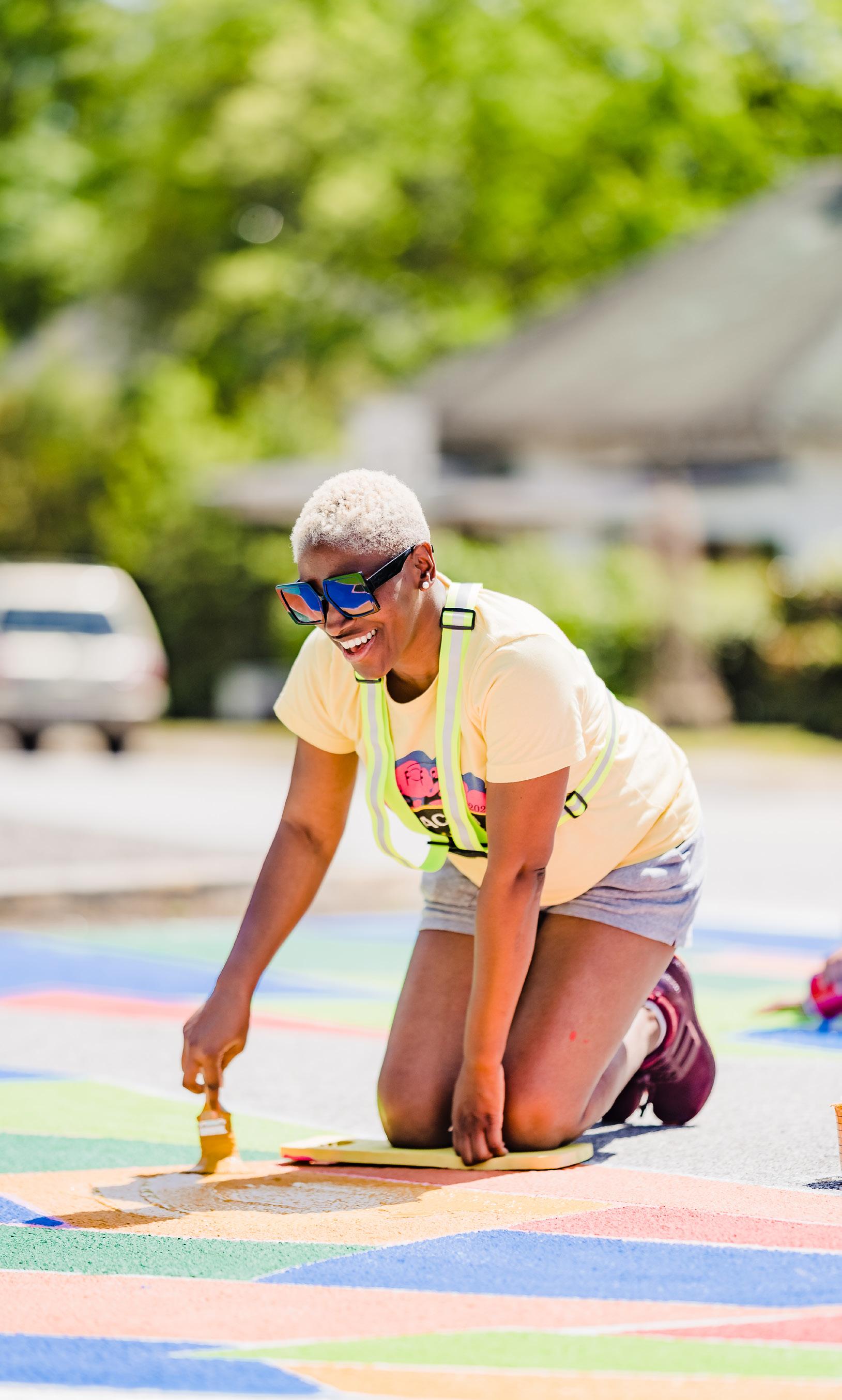
Growing Together: How Public Space Is Powering Climate Resilience
in Philadelphia
Philadelphia’s climate solutions are rooted in its neighborhoods. Through projects that restore natural landscapes, reimagine underused parks and grow the urban forest, the city is showing that sustainability starts with shared spaces and collective stewardship. With a focus on historically disinvested communities and long-term ecological health, the city’s commitment to its civic and natural environments illustrate how public space can become the foundation of a more equitable and sustainable future.
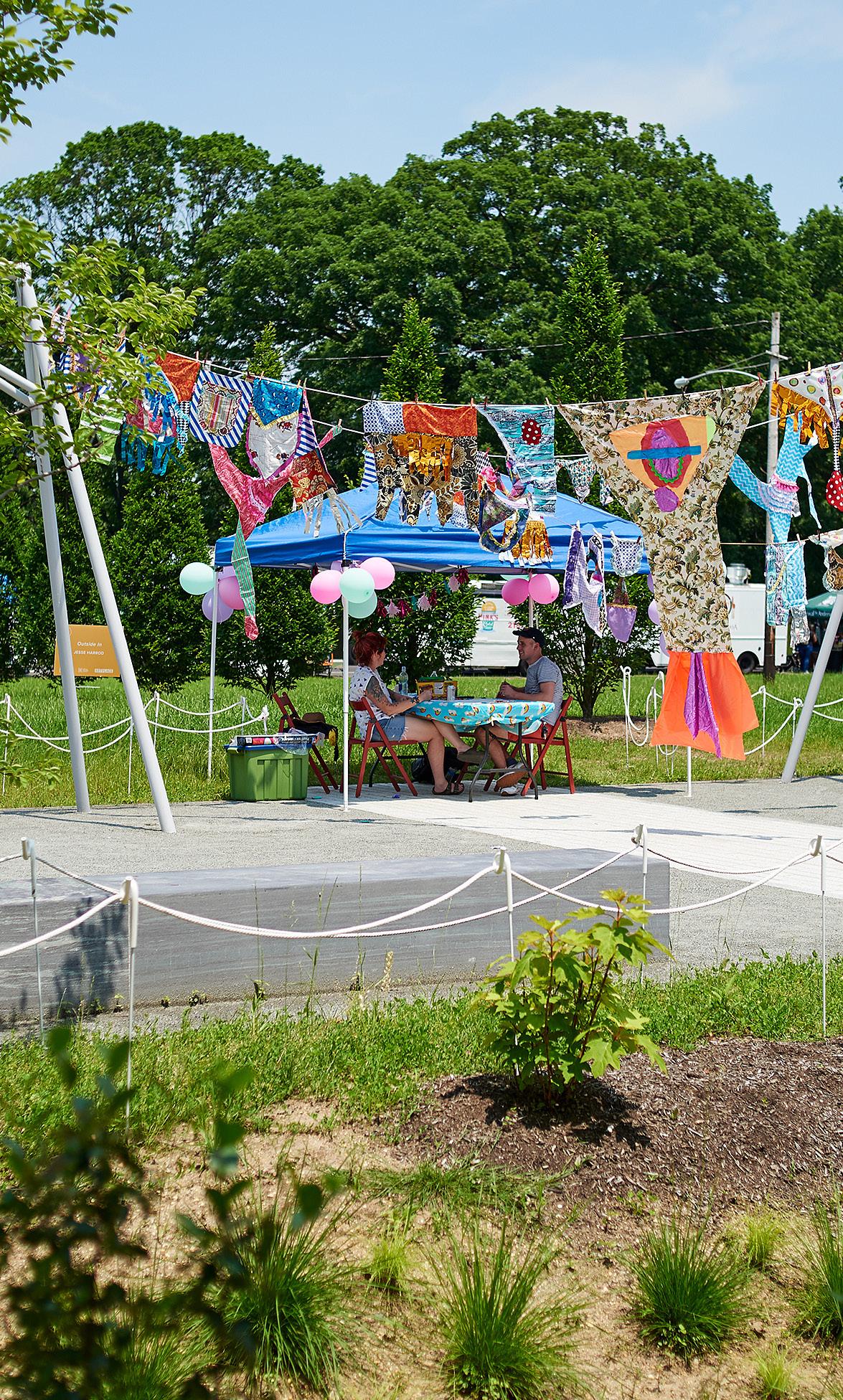
Parkside Edge: Reclaiming the Civic Front Porch
For decades, the stretch of Fairmount Park that borders Parkside Avenue was overlooked — vast in scale but sparse in use. Despite its proximity, many neighbors felt the area had little to offer them, given a lack of amenities such as lighting, seating and safe crossings. Residents had fond memories of the park’s vibrant history, but decades of disinvestment led to neglect, giving present-day visitors few reasons to linger. A new future for this once beloved public space was needed, one that reconnects residents with the park, the natural environment and each other.
In 2019 Fairmount Park Conservancy, in collaboration with city agencies and Centennial Parkside CDC (CPCDC), launched a new vision: Parkside Edge. Designed as a neighborhood-scale civic commons, the project emphasized both ecological function and social connection. A series of small-scale public spaces with seating and swings (called “porches” by locals) encourage residents to gather, while rain gardens and native plantings — featuring 42 species and 68 newly-planted trees — mitigate stormwater and bring biodiversity to the corridor.
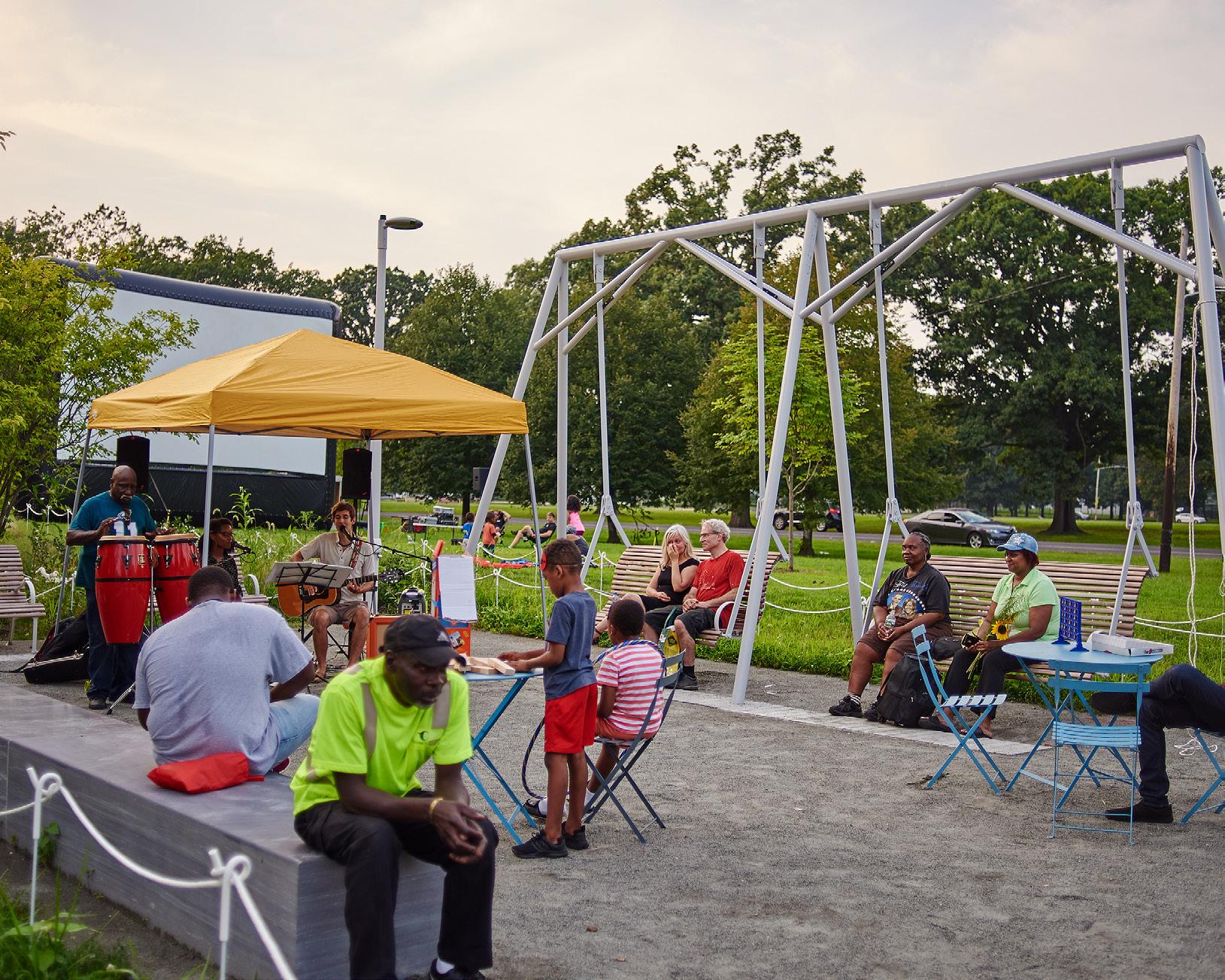
Parkside Edge has been maintained by the Conservancy and CPCDC’s Clean and Green Team, a locally hired crew whose stewardship deepens community ownership and ensures lasting care. Their presence is a reminder that sustainability isn’t just environmental — it’s economic and social, too.
Pedestrian safety upgrades, including bike lanes, a roundabout and a pop-up plaza at the historic Welsh Fountain, have made the park more accessible and welcoming. Through these layered interventions, the once-neglected Parkside Edge has become a green front porch that belongs to the people.
“One of the most powerful testaments to the enduring success of the Parkside Edge project is how engaged the neighbors continue to be nearly a decade after the project’s inception. I’m routinely inspired by the level of involvement and care that the community takes in stewarding this landscape alongside Fairmount Park Conservancy.”
- Darren Damone
Director of Landscapes Fairmount Park Conservancy
Growing Canopy, Reducing Inequity: The Philly Tree Plan
Tree canopy is one of the most visible — and unequal — features of Philadelphia’s urban landscape. While some neighborhoods enjoy more than 45% tree canopy, others have less than 5%. These disparities often fall along the lines of class and race, further entrenching inequitable climate change consequences into marginalized communities. Between 2008 and 2018, the city lost 6% of its canopy — an area roughly the size of a thousand football fields — due to improper maintenance, the removal of yard trees and the adverse effects of climate change.
In response, Philadelphia launched the Philly Tree Plan in 2020, an ambitious strategy to grow, protect and equitably distribute the city’s urban forest. This plan wasn’t written behind closed doors. It was created through a multi-year civic process led by the city’s Department of Parks & Recreation. Neighborhood ambassadors, community voices committees, workshops, surveys and open houses ensured that the plan reflected the experiences and values of Philadelphia residents. Community stewardship is a vital component of this plan beyond the initial planning stage, with tree care teams locally hired and trained by PowerCorps PHL, one of the city’s workforce development organizations.
By approaching trees as public assets, the city and its Tree Plan partners work to steadily bridge the gap between neighborhood tree coverage and distribute the positive effects of urban forestry to communities that have historically lacked these benefits. Trees provide vital relief from urban heat surges, manage stormwater, filter our air and improve our mental and physical wellness. In many communities, they are sites of memory, storytelling and pride. With a 30-year goal to reverse the city’s loss in tree coverage beginning with the neighborhoods that have historically lacked greenery, Philadelphia is promoting environmental equity and sustainability for this generation and those to come.
From Lawns to Life: Mows to Meadows
For years, wide grassy swaths of West Fairmount Park were routinely mowed out of habit. The practice consumed maintenance dollars and fossil fuels while the fields were underutilized by parkgoers. Today, these spaces are on their way to becoming vibrant meadows supporting biodiversity, managing stormwater and inviting visitors into a richer experience of nature.
Thanks to the Fairmount Park Conservancy’s Mows to Meadows program, four target sites — Georges Hill, Ohio House, and MLK North and South meadows — are being rewilded. As a result, approximately five acres of grass are now transitioning to native meadows that will bloom with color and activity, drawing pollinators and pedestrians alike. This quiet transformation is a subtle but significant shift in land stewardship: an acknowledgment that low-maintenance does not mean low-value, and that beauty can serve both people and the environment. By returning the green space to its original wilded state, Fairmount Park Conservancy is using the past as a means to ensure a sustainable future.
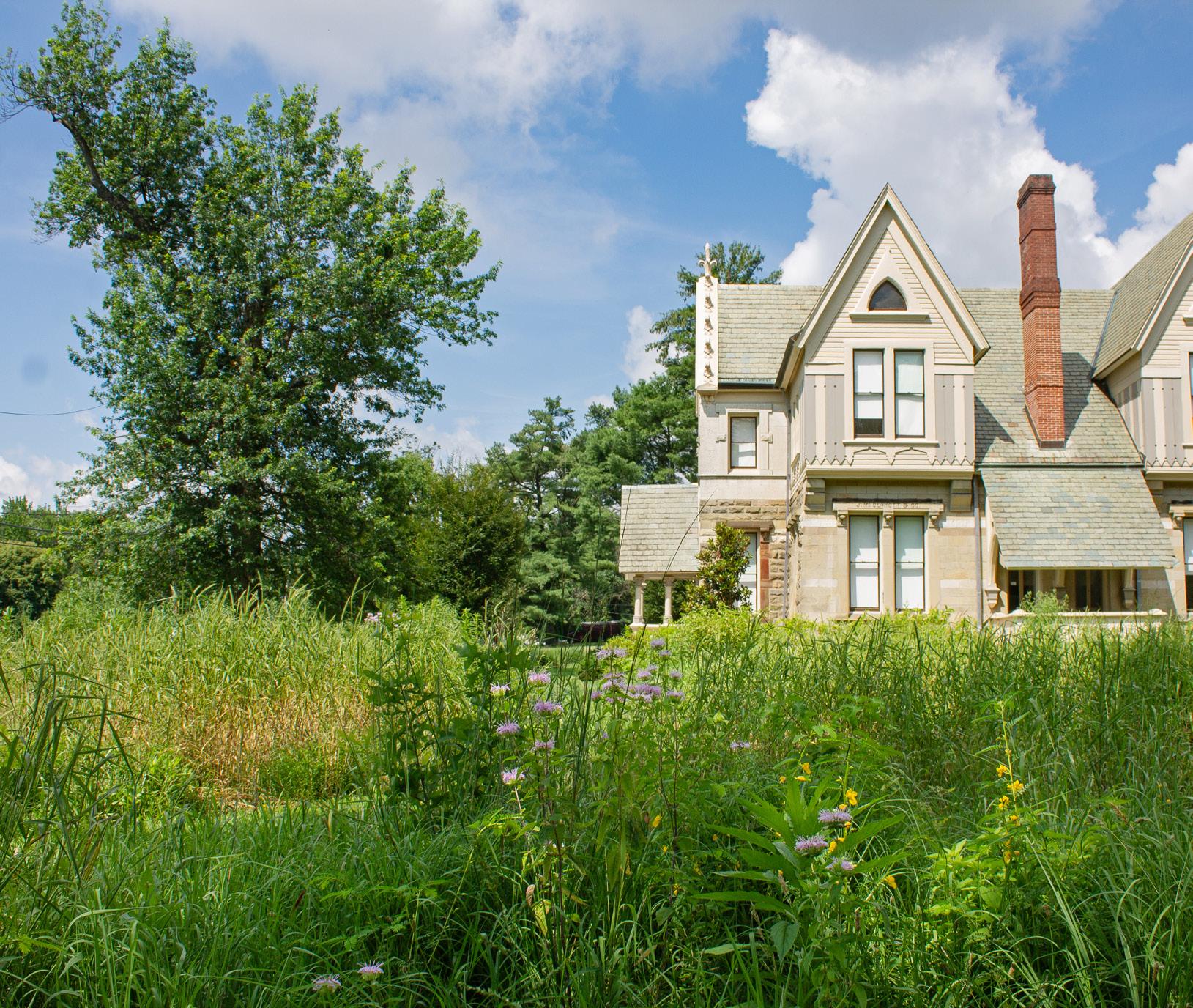
A Park for All: FDR’s Resilient Transformation
No space captures Philadelphia’s evolving climate vision more comprehensively than FDR Park. Beloved for generations, this South Philadelphia green space has been a natural oasis and destination public space for residents and visitors alike. However, the park has recently struggled with underfunding, deferred maintenance and frequent floodings. Due to the location in a 100-year floodplain, runoff from nearby impervious surfaces, poor drainage and a broken tide gate, sections of FDR Park are at risk of being entirely underwater within the next two decades.
Enter the FDR Park Plan: a once-in-a-century investment in climate adaptation, resilience and public space. Developed in collaboration between Fairmount Park Conservancy, the Philadelphia Parks & Recreation Department and local design firm WRT with input from more than 3,000 residents and stakeholders, the FDR Park Plan aims to preserve the park’s historic landscape while addressing chronic flooding, expanding community access to nature and embracing environmental sustainability. The plan has two key components: first, a 209-acre section of the park will become a natural system of meadows, wetlands and waterways designed to absorb stormwater, support wildlife and connect residents to nature. Soil excavated from this area will then raise other parts of the park above the floodplain, creating spaces for future playgrounds, a welcome center, athletic fields and picnic areas that are safer from flood risk.
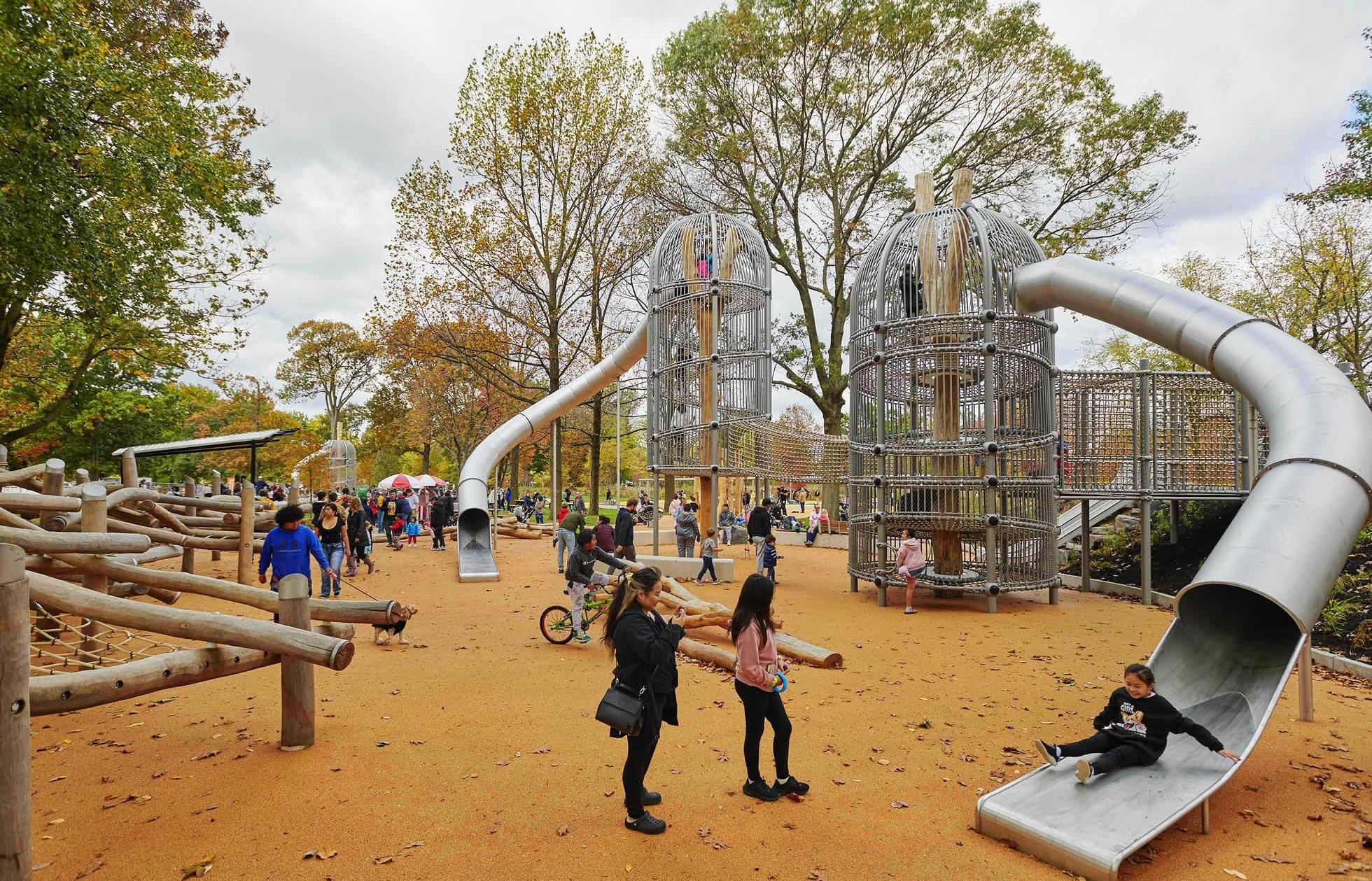
Initiatives such as a tidal wetlands restoration and expansion of the Shedbrook Creek will restore native habitats while offering new opportunities for exploration — kayaking, birdwatching and nature walks in areas that were once largely inaccessible. Once restored, these spaces will become natural habitats replete with clean water, wildlife and nearly 7,000 new trees and 1,700 new shrubs. In returning to its literal roots, large segments of FDR Park will provide visitors a respite from bustling urban life, connect people to nature and support the sustainable and resilient future of parkland, wildlife and native plantings for decades to come.
Notably, this revitalization includes clear efforts to couple resilience with community connection and active public space. A centerpiece of this effort is the Anna C. Verna Playground, an approximately two-acre all-ages play space that replaced a frequently flooded, inaccessible and aging playground. The new design features a 100% permeable surface, native landscaping that supports pollinators and 31 new trees. A 20-seat “mega” swing set — the largest in North America — is set among log scrambles and custom-made slide towers designed to build children’s confidence through adventurous play. New picnic infrastructure invites multigenerational use and establishes the playground as a meeting place for families and friends.
Nearby, a new welcome center has reimagined the historic guardhouse and stables into a community hub featuring event rooms, public restrooms, food vendor spaces and a 5,000-square-foot outdoor courtyard. At the edge of the park most accessible via public transit, a new plaza creates a welcoming entrance with cooling misters, plentiful seating, bike racks and rain gardens planted with native species, designed to handle stormwater while enhancing the visitor experience.
Together, these improvements create harmony between climate adaptation and neighborhood needs. They reinforce the idea that environmental stewardship is not just about conservation — it’s about making public space joyful, accessible and deeply rooted in the communities it serves. FDR Park exemplifies how natural assets, when nurtured through inclusive programming and sustainable design, can cultivate a deeper connection between people and place.
Reclaiming Nature, Reclaiming Community at Bartram’s Garden
Tucked along the western bank of the Schuylkill River, Bartram’s Garden has evolved from a historic botanic garden into a dynamic civic commons — one that centers its surrounding community and fosters deep connections to food, nature and neighbors. While its 50-acre landscape is home to native meadows, wetlands and a restored riverfront, the garden’s thoughtful programming and local partnerships bring these spaces to life.
Bartram’s Garden has become a neighborhood anchor in Southwest Philadelphia through programs that blend environmental education, recreation and food sovereignty. One initiative that is bringing the benefits of the botanic garden beyond its footprint is the home gardening program, which began in 2021 by installing raised beds at 60 homes across the neighborhood. This hyperlocal approach supports residents growing their own food while fostering relationships and knowledge-sharing between neighbors.
At the water’s edge, a community boathouse and dock offer free access to kayaks, rowboats and fishing gear, drawing new visitors to the river and expanding the invitation to enjoy the waterfront. Bartram’s Mile, a onemile extension of the Schuylkill River Trail, connects communities to these amenities and to each other, linking neighborhoods with a car-free, natureforward route for biking, walking and gathering. Plans are currently underway to connect the Garden and the Southwest Philadelphia neighborhood to downtown (and beyond).
Ongoing, inclusive programming expands the structure of ownership and engagement. Through partnerships with organizations like the city’s Parks & Recreation department and the Bicycle Coalition of Greater Philadelphia, Bartram’s Garden offers youth summer camps, bike riding lessons and urban farming education. Events such as Juneteenth and Springfest celebrate local culture and collective memory in an ecological setting. As a result, Bartram’s Garden is not only a space for restoration of land, but of people, memory and community as well.
Rooted in Place, Grown by People
In each of these Philadelphia stories, the throughline is clear: public space is a foundation for climate resilience and community connection. By leading with equity, centering local voices and investing in long-term environmental health, Philadelphia is not only confronting the climate crisis — it’s reimagining who public space is for and what it can do.
As the tree canopy regrows and the meadows bloom, so does something less visible but just as vital: community connection to nature. And from that connection grows stewardship, belonging and the possibility of a city where sustainability is not a siloed initiative, but a shared way of life.
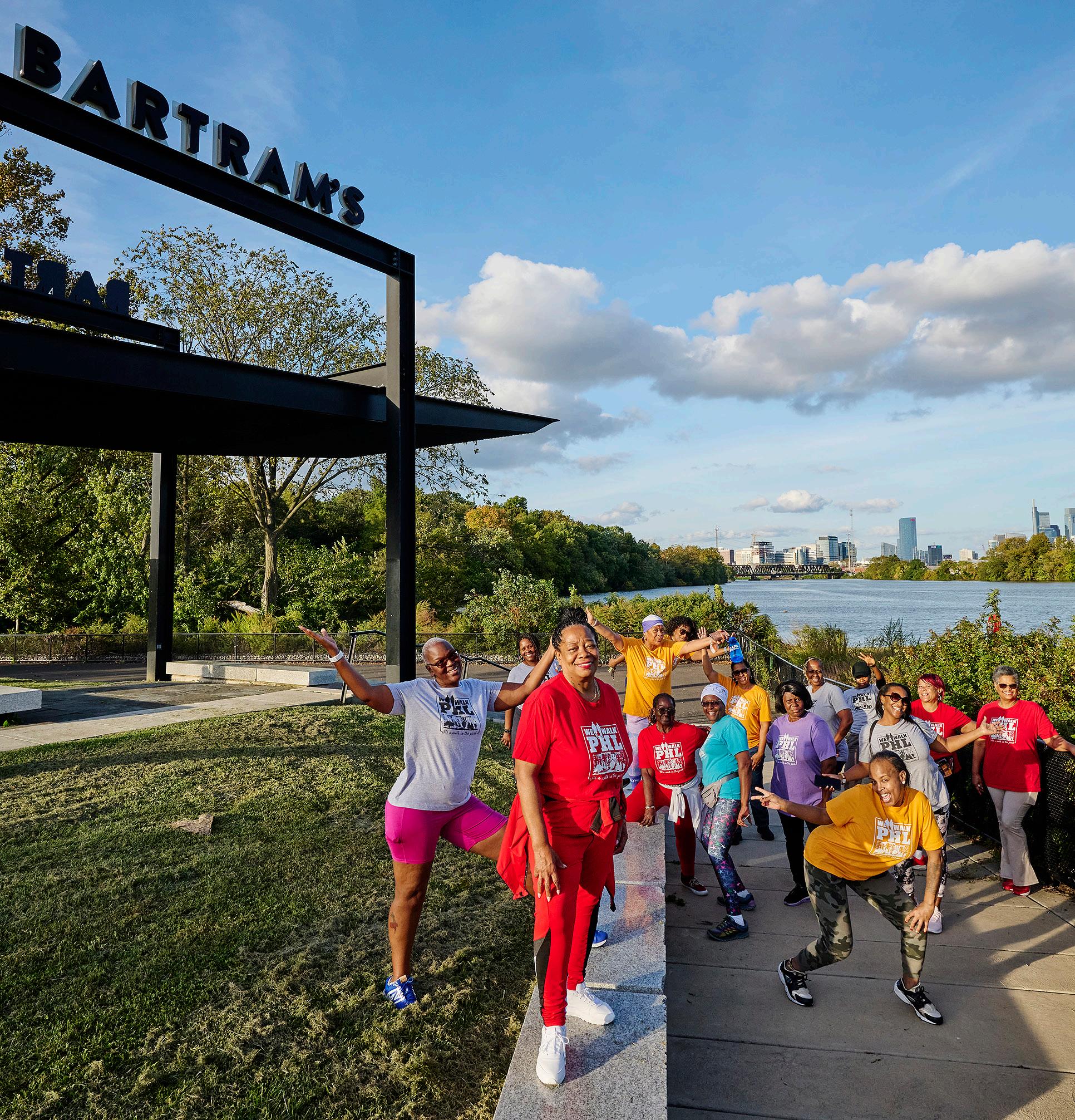
Bishan-Ang Mo Kio Park: Reimagining Urban Nature in Singapore
Bishan-Ang Mo Kio Park in Singapore is a powerful example of how integrating nature into urban infrastructure can transform an underutilized space into a vibrant, resilient and inclusive public asset. By replacing a concrete canal with a naturalized river system, the park now manages stormwater more effectively, boosts biodiversity and strengthens community connections — demonstrating the far-reaching value of sustainable, people-centered design.
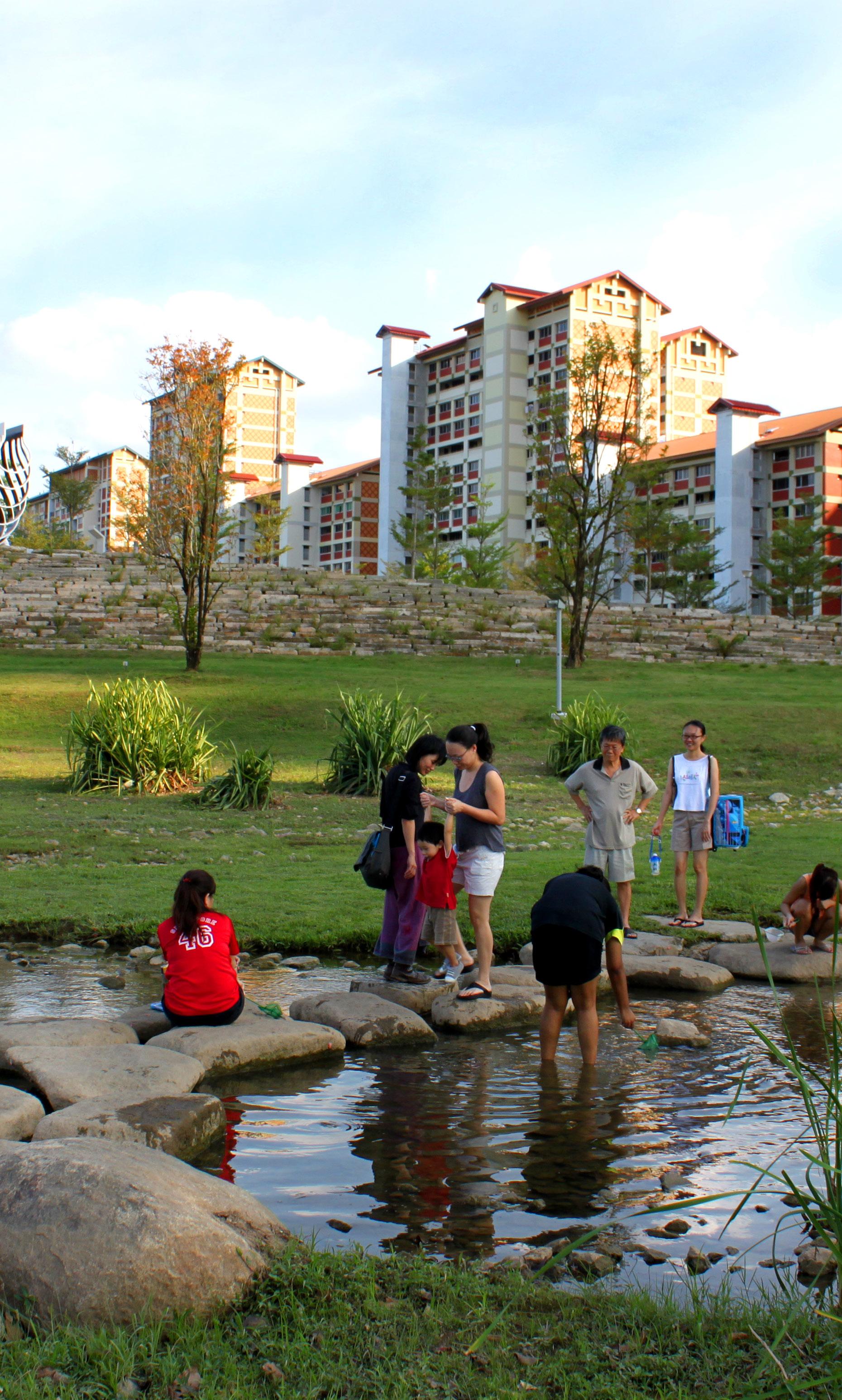
In the heart of Singapore’s densely populated neighborhoods, BishanAng Mo Kio Park serves as a testament to the transformative power of integrating nature into urban environments.
Originally constructed in 1988 as a green buffer between the Bishan and Ang Mo Kio residential towns, the park was characterized by a concrete drainage canal that separated communities and limited ecological interaction. Recognizing the potential for a more harmonious relationship between urban living and natural ecosystems, Singapore embarked on a visionary project to revitalize the park, enhancing both its environmental functionality and civic value. As a result, the park’s redesign has enhanced public space, strengthened social connections and promoted long-term environmental sustainability.
In 2006, the country’s national water agency PUB implemented the Active, Beautiful and Clean Waters Program, which sought to reimagine water bodies beyond their basic function and unlock their greater potential for civic and social benefits. Bishan-Ang Mo Kio Park became a key site for redesign, which involved replacing the concrete drainage channel with a three-kilometer meandering river. Designed using soil bioengineering and planted riverbanks, this new waterway mimics the behavior of natural streams — expanding during storms and receding in dry weather. Rather than confining floodwater, the design embraces it, using open spaces to safely absorb and slow runoff. This design effectively enhances the park’s ability to manage stormwater by 40% compared to its prior capacity and returns the park to recreational function within hours after a rain event. But this ecological upgrade also reshaped the park’s social life. Once a divider between communities, the river now invites gathering: paths, lawns and seating bring people closer to the water, nature and each other.
By embracing nature-based solutions, the park has become a living system — one that manages climate risk while enhancing public life. The redesign has led to a 30% increase in biodiversity by introducing a variety of native plant species and creating diverse habitats. With its variety of micro-habitats, the restored river has enhanced the resilience of species within the park, effectively improving their ability to survive in the long-term.
In restoring a river to its natural rhythm, Singapore also restored a sense of community and vibrancy to the neighborhoods the waterway flows through. The park’s lawns teem with civic life, hosting everything from festivals to
tai chi groups. Playgrounds, fitness corners and cafes dot the park’s edge, providing a variety of experiences. Its design encourages visitors to interact with and learn about the natural environment, and the removal of physical barriers to the river helps foster a sense of ownership and accessibility. The project reminds us that when environmental sustainability is embedded in public space, the benefits ripple far beyond flood protection or habitat. They create places where people gather, relate and belong.
By integrating natural systems into the urban fabric, the park not only addresses practical concerns like flood management but also creates a communal space that reconnects residents with nature. This holistic approach serves as an inspiring model for cities worldwide seeking to enhance their public spaces through sustainable and inclusive design.
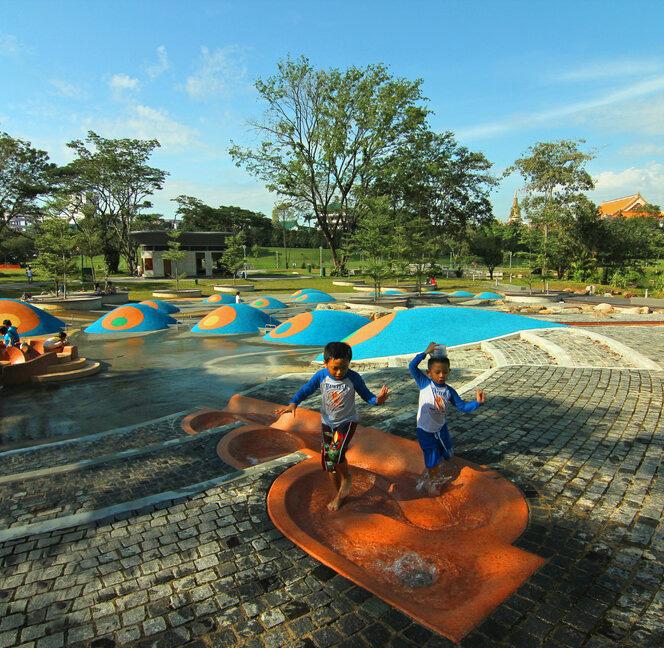
Lafitte Greenway: A Resilient Corridor for New Orleans’ Climate and Community
The Lafitte Greenway in New Orleans exemplifies how sustainable infrastructure and inclusive public space can work hand-in-hand to restore community, equity and environmental resilience. Once an abandoned rail corridor, the Greenway is now a vital green artery that manages stormwater, cools the city and fosters everyday civic life — all shaped by deep community stewardship and a commitment to shared benefit.
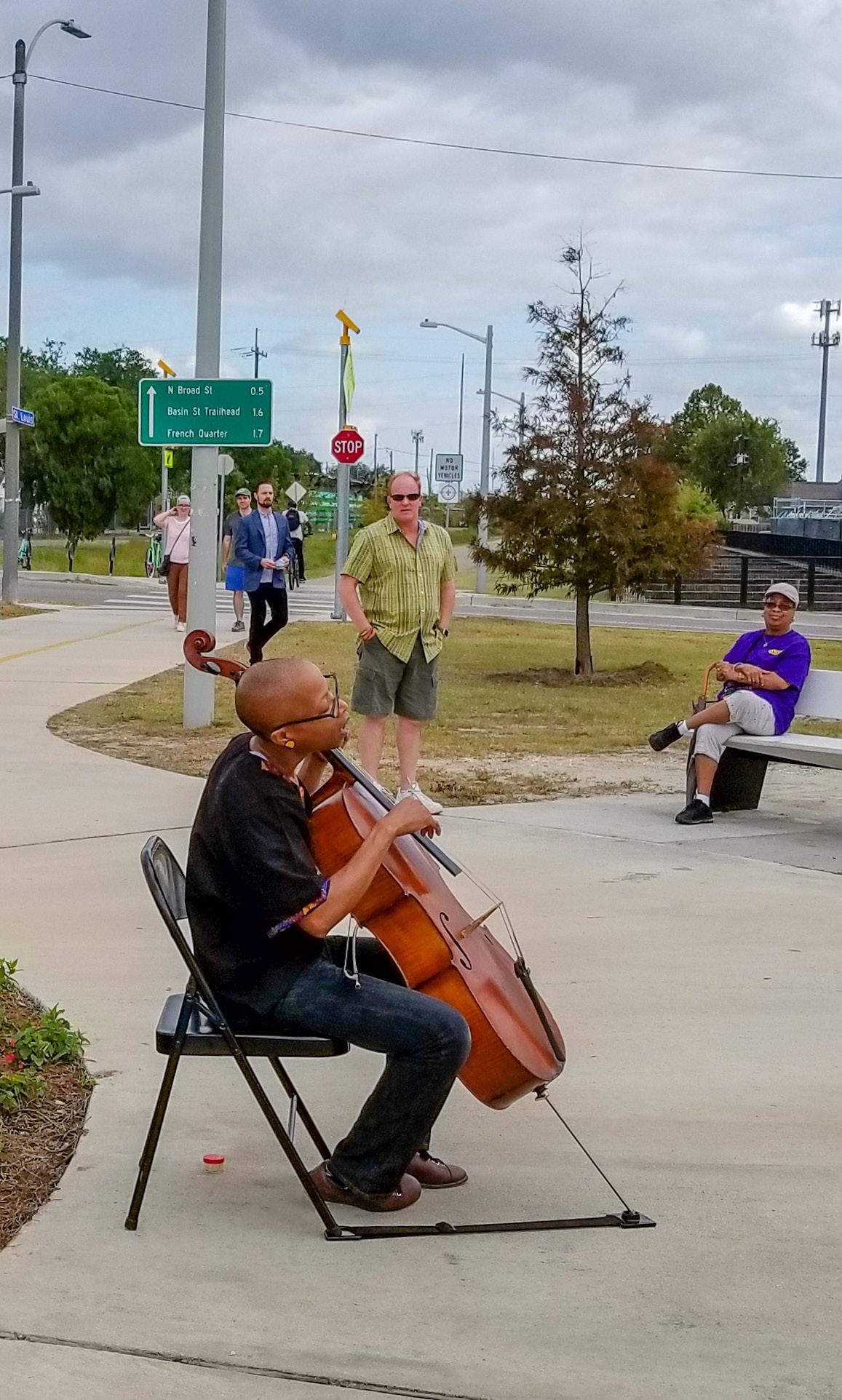
In New Orleans, the Lafitte Greenway offers a powerful example of how environmental sustainability and public space can work together to reconnect people and place.
Born from a volunteer-led movement after Hurricane Katrina, the Lafitte Greenway was envisioned as a space where neighbors could walk, bike, gather and heal. This eventually led to the formation of the Lafitte Greenway Partnership, a nonprofit responsible for ongoing operations and maintenance of the Greenway in collaboration with the City of New Orleans. Once an abandoned rail corridor, the Greenway is now a 2.6-mile linear park and trail that weave through six neighborhoods, linking Mid-City to the French Quarter. More than a trail, the Greenway acts as a vital artery in the city’s growing 120-mile bicycle network. The Greenway also serves as a key public place, one that promotes resilience, fosters social connection and redresses long-standing disparities in access to urban green space.
The Greenway prioritizes sustainability at every turn: bioretention swales and rain gardens line the corridor, capturing and filtering 37% of annual rainfall and intercepting an additional 24,000 cubic feet of runoff each year through tree canopy alone. A cypress forest and pollinator meadows cool the air and sequester over 12,000 pounds of carbon annually — equivalent to eliminating nearly 14,000 miles driven by a typical car. Compared to adjacent areas, temperatures in the Greenway are up to 8°F cooler, demonstrating the critical role public green space plays in mitigating urban heat.
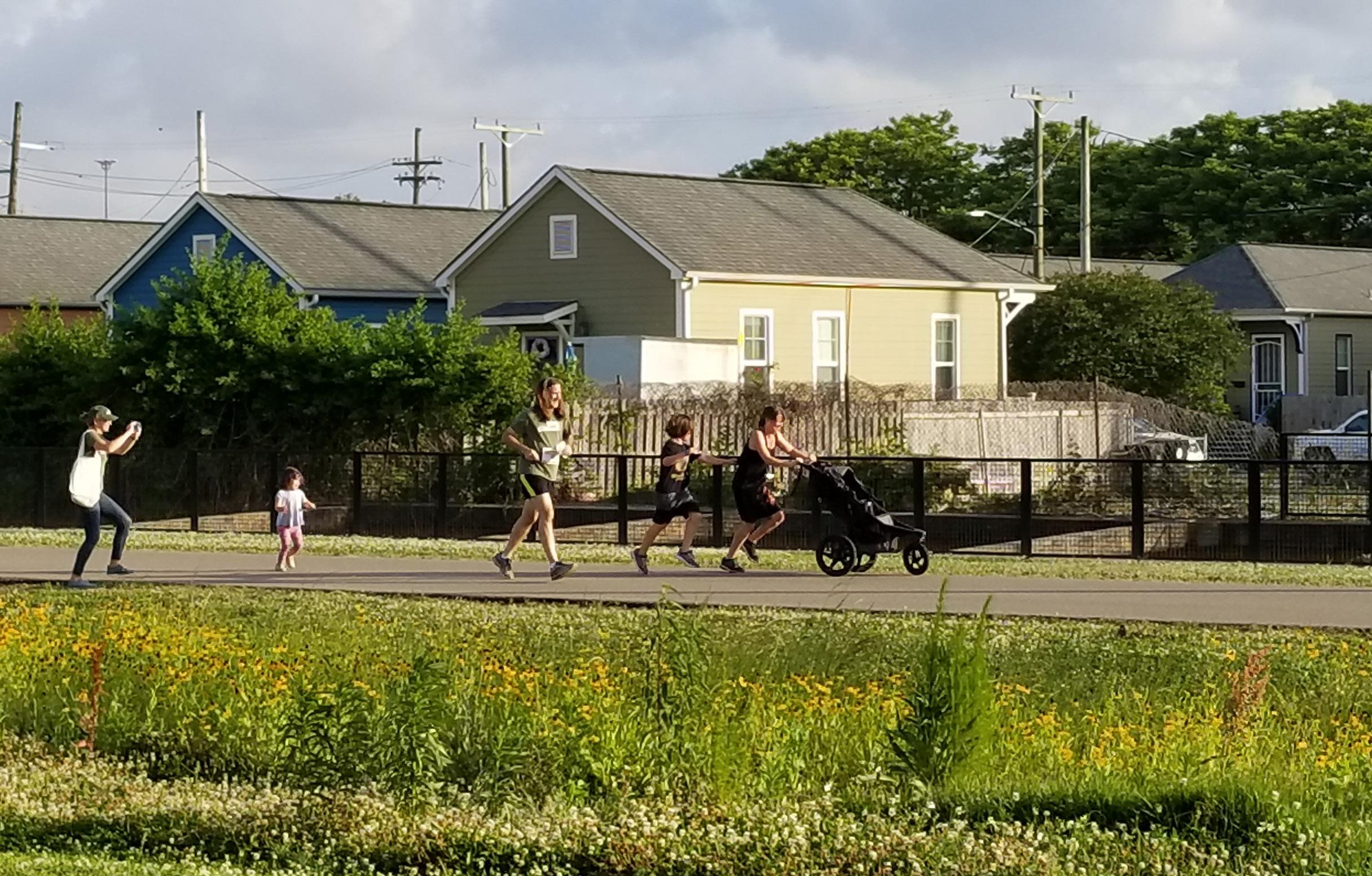
These environmental benefits are inseparable from the Greenway’s social impact. Nearly 1,000 people utilize the path everyday, drawn not only by its scenic route but by the life that unfolds along it — farmers markets, community events, cultural festivals and fitness classes that turn infrastructure into gathering space. The Greenway Plaza, which opened in the winter of 2020, reflects this ethos. Co-designed with input from over 200 residents, the Plaza features public art, flexible gathering spaces, a stage, native plantings and shaded seating — a civic square built by and for the community.
Throughout the Greenway’s evolution, the role of public participation has remained central. Its design and growth have been shaped by thousands of volunteer hours — from conceptualizing the original plan to planting trees and removing invasive species to clearing bioswales and removing graffiti. Since 2015, over 50,000 residents have been involved in the Greenways volunteer and community events. In 2024 alone, 480 volunteers donated more than 2,000 hours, reinforcing a sense of shared stewardship that sustains the Greenway as a living commons. This volunteerism is more than maintenance; it is an ongoing act of civic care that strengthens local ownership and connection to the environment.
As the Greenway continues to expand — with plans underway to collaborate with the City of New Orleans to extend the trail to the RTA Cemeteries Transit Plaza — it is also reshaping the city’s economic geography. Guided by a community-developed Trail-Oriented Development Plan, new investments have begun to emerge that align with the values espoused by the Greenway’s advocates. Since the Greenway opened in 2015, there has been over $360 million in new development, including 635 units of market rate housing, 1,114 units of affordable housing and 440,000 square feet of office, restaurant, and retail spaces. Nearby residential real estate prices have climbed by an estimated 60%. Yet the Lafitte Greenway Partnership and its allies remain focused on ensuring that this growth honors the Greenway’s original promise to be an asset that reflects and benefits all communities it touches.
The Greenway’s measurable benefits — cooler temperatures, improved water management and carbon reduction — are impressive. But just as powerful are the everyday moments of community connection it enables. Throughout the Lafitte Greenway, resilience is not just ecological, but civic too. In turning vacant land into a vibrant, climate-friendly commons, the Lafitte Greenway shows what is possible when environmental sustainability is pursued as a public good. It is a reminder that green infrastructure, when rooted in equity and community care, can become the connective tissue of a more resilient city.
Abera, Y. A. (2024, May 16). Sustainable building materials: A comprehensive study on eco-friendly alternatives for construction. Composites and Advanced Materials, 33. https://doi.org/10.1177/26349833241255957
Aldrich, D. P. (2023, November 20). How Libraries (and Other Social Infrastructure Spaces) Will Save Us: The Critical Role of Social Infrastructure in Democratic. Fulbright Flinders University Lecture Series 8 2023. http://dx.doi.org/10.2139/ ssrn.4639061
Aldrich, D. P. (2023). How social infrastructure saves lives: A quantitative analysis of Japan’s 3/11 disasters. Cambridge University Press. https://www.cambridge. org/core/journals/japanese-journal-of-political-science/article/how-socialinfrastructure-saves-lives-a-quantitative-analysis-of-japans-311-disasters/4BD3AA19 6B334A23F0B749E85AE4E38F
American Society of Civil Engineers. (2022, May 23). Studying the impact of impervious land cover on flooding and urban areas. https://www.asce.org/publicationsand-news/civil-engineering-source/article/2022/05/23/studying-the-impact-ofimpervious-land-cover-on-flooding-in-urban-areas
American Society of Landscape Architects. (2016). ASLA Professional Awards: BishanAng Mo Kio Park. American Society of Landscape Architects. https://www.asla. org/2016awards/169669.html
Armand, W. (2024, April 19). How do trees and green spaces enhance our health? Harvard Health Publishing. https://www.health.harvard.edu/blog/how-do-treesand-green-spaces-enhance-our-health-202404193034
Beckwith, B. R., Johansson, E. M., & Huff, V. J. (2022). Connecting people, plants and place: A native plant society’s journey towards a community of practice. People and Nature, 4, 1414–1425. https://doi.org/10.1002/pan3.10368
Botchwey, Nisha. Dannenberg, Andrew L. Frumkin, Howard. (2022). Making healthy places (2nd ed.) Island Press.
C40 Cities Climate Leadership Group, C40 Knowledge Hub. (2023). Climate budgeting: What it is, what it is not, and how it works. C40. https://www.c40knowledgehub. org/s/article/Climate-budgeting-What-it-is-what-it-is-not-and-how-itworks?language=en_US
C40 Cities Climate Leadership Group, C40 Knowledge Hub. (2024). How cities can attract private finance for climate action. C40. https://www.c40knowledgehub.org/s/ article/How-cities-can-attract-private-finance-for-climate-action?language=en_US
Citizen Portal. (2025, August 8). New Orleans Council Approves Lafitte Greenway Partnership Agreement for Recreational Use. https://www.citizenportal.ai/ articles/5555358/New-Orleans-City/Orleans-Parish/Louisiana/New-OrleansCouncil-Approves-Lafitte-Greenway-Partnership-Agreement-for-Recreational-Use
Children & Nature Network. (n.d.). Nature-smart libraries: A toolkit. https://www. childrenandnature.org/resources/nature-smart-libraries-a-toolkit/
City of Philadelphia. (2023). Philly Tree Plan. https://www.phila.gov/ media/20230223005617/Philly-Tree-Plan.pdf
Daley, J. (2023, October 1). We need tree equity for climate justice. American Forests. https://www.americanforests.org/article/we-need-tree-equity-for-climate-justice/ Designing our future: sustainable landscapes. (n.d.). https://www.asla.org/ sustainablelandscapes/greenstreet.html
Environmental Protection Agency. (2025, April 3). What are heat islands? https://www. epa.gov/heatislands/what-are-heat-islands
Environmental Protection Agency. (2025, April 2). Using green roofs to reduce heat islands. https://www.epa.gov/heatislands/using-green-roofs-reduce-heat-islands
Environmental Protection Agency. (2025). Municipal bonds and green bonds. https:// www.epa.gov/statelocalenergy/municipal-bonds-and-green-bonds
Environmental Protection Agency. (2025, June 4). Green infrastructure funding and technical assistance opportunities. Environmental Protection Agency. https:// www.epa.gov/green-infrastructure/green-infrastructure-funding-and-technicalassistance-opportunities
Fairmount Park Conservancy. (2023, July 11). FDR Park Plan – Fairmount Park Conservancy. https://myphillypark.org/fdr-park-plan/
Fairmount Park Conservancy. (2025). Projects: FDR Park Plan. Fairmount Park Conservancy. https://myphillypark.org/what-we-do/projects/fdr-park/
Fairmount Park Conservancy. (2025). Projects: Parkside Pedestrian Improvements. Fairmount Park Conservancy. https://myphillypark.org/what-we-do/projects/ parkside-pedestrian-improvements/
Fraser, T., Yabe, T., Aldrich, D. P., & Moro, E. (2024). The great equalizer? Mixed effects of social infrastructure on diverse encounters in cities. Computers, Environment and Urban Systems, 113, 102173. https://doi.org/10.1016/j.compenvurbsys.2024.102173
Gagg, Colin R. (2014, May). Cement and concrete as an engineering material: An historic appraisal and case study analysis. https://www.sciencedirect.com/science/ article/abs/pii/S1350630714000387#:~:text=Highlights,and%20associated%20 costs%20of%20rectification
Guadalupe River Park Conservancy. (2025). Come Explore. Guadalupe River Park Conservancy. https://grpg.org/
Hahn, A. (2018, June, 18). Centennial Commons carves out space for east Parkside neighbors to connect. WHYY. https://whyy.org/segments/centennial-commonscarves-out-space-for-east-parkside-neighbors-to-connect/
Hilbert, D. R., Roman, L. A., Koeser, A. K., Vogt, J., van Doorn, N. S. (2019, September). Urban Tree mortality: A Literature Review. Arboriculture & Urban Forestry, 45(5), 167200. https://www.fs.usda.gov/nrs/pubs/jrnl/2019/nrs_2019_hilbert_001.pdf
International Living Future Institute. (2025). Living Building Challenge. International Living Future Institute. https://living-future.org/lbc/
International WELL Building Institute. (2025). WELL. International WELL Building Institute. https://www.wellcertified.com/
Jennings, V., & Bamkole, O. (2019). The Relationship between Social Cohesion and Urban Green Space: An Avenue for Health Promotion. International Journal of Environmental Research and Public Health, 16(3), 452. https://doi.org/10.3390/ ijerph16030452
Joshi, K., Khan, A., Anand, P. et al. Understanding the synergy between heat waves and the built environment: a three-decade systematic review informing policies for mitigating urban heat island in cities. Sustain Earth Reviews 7, 25 (2024). https://doi. org/10.1186/s42055-024-00094-7
Kasriel, E. (2020, May 2). Coronavirus: How green spaces are helping people through the pandemic. BBC News. https://www.bbc.com/news/health-52479763
Lafitte Greenway Partnership. (2024). Strategic Plan: 2024-2027. Lafitte Greenway Partnership. https://assets.nationbuilder.com/folc/pages/1277/attachments/ original/1726258859/Lafitte_Greenway_Partnership_-_Strategic_Plan_%2820242027%29.pdf?1726258859
Lafitte Greenway Partnership. (2025). Get Involved: Community is at the heart of Lafitte Greenway’s work. Lafitte Greenway Partnership. https://lafittegreenway.org/getinvolved/
Larson, L. R., Hipp, J. A. (2022, March 1). “Nature-Based Pathways to Health Promotion: The Value of Parks and Greenspace. North Carolina Medical Journal, 83 (2), 99–102. https://doi.org/10.18043/ncm.83.2.99.
Lee, S., Koo, B. W., & Kim, Y. (2023). Associations between tree characteristics and street crime: A case study in downtown Austin, TX. Urban Forestry & Urban Greening, 87, 128046. https://doi.org/10.1016/j.ufug.2023.128046
Li, J., & Burian, S. J. (2022). Effects of nonstationarity in urban land cover and rainfall on historical flooding intensity in a semiarid catchment. Journal of Sustainable Water in the Built Environment, 8(2). https://doi.org/10.1061/JSWBAY.0000978
NACTO. (n.d.). Stormwater Management. https://nacto.org/publication/urban-streetdesign-guide/street-design-elements/stormwater-management/
Natural Capital Project. (n.d.). Sustainable, livable cities. Stanford University. https:// naturalcapitalproject.stanford.edu/projects/featured/sustainable-livable-cities
Nesbitt, L., Meitner, M. J., Girling, C., Sheppard, S. R. J., & Lu, Y. (2019). Who has access to urban vegetation? A spatial analysis of distributional green equity in 10 US cities. Landscape and Urban Planning, 181, 51–79. https://doi.org/10.1016/j. landurbplan.2018.08.007
Passive House Institute. (2024). Passive House Institute. Passive House Institute. https://passivehouse.com/
Patrick, J. (2023, February 21). Designing for health and well-being: 5 questions with public health and built environment expert Nisha Botchwey. Medium. https:// medium.com/reimagining-the-civic-commons/designing-for-health-and-wellbeing-b5994303645a
Peterson, S. (2025, June 30). Sneak Peek: FDR Park’s Welcome Center is Complete! –Fairmount Park Conservancy. Fairmount Park Conservancy. https://myphillypark. org/sneak-peek-fdr-parks-welcome-center-is-complete/
Poole, R. (2023, May 23). Nature Phase will expand natural areas at FDR Park –Fairmount Park Conservancy. Fairmount Park Conservancy. https://myphillypark. org/nature-phase/
Poole, R. (2024, March 15). Celebrating the Anna C. Verna Playground grand opening! –Fairmount Park Conservancy. Fairmount Park Conservancy. https://myphillypark. org/anna-c-verna-playground-grand-opening/
Reimagining the Civic Commons. (2021). Connecting with nature and one another: Ideas for bringing people together in a nature-rich public realm. Medium. https:// medium.com/reimagining-the-civic-commons/connecting-with-nature-and-oneanother-6cf0babb9126
Reimagining the Civic Commons. (2023, September 12). Why public space is a critical tool for climate resilience. Medium. https://medium.com/reimagining-the-civiccommons/why-public-space-is-a-critical-tool-for-climate-resilience-9ebc4bfa82c
Riggs, Trish. (2016, April 25). Trail-Oriented Development: The Next Frontier in People Friendly Design. Urban Land Institute. https://urbanland.uli.org/infrastructuretransit/trail-oriented-development-new-uli-report-looks-next-frontier-peoplefriendly-design
Rigolon, A., & Collins, T. (2022). The green gentrification cycle. Urban Studies, 60(4), 770-785. https://doi.org/10.1177/00420980221114952
Romero, M. (2021, September 28). Mows to Meadows project will bring 5 acres of meadows to Fairmount Park. Fairmount Park Conservancy. https://myphillypark. org/mowstomeadows/
Romero, M. (2018, October 26). The incredible transformations of 5 Civic Commons sites in Philadelphia. Fairmount Park Conservancy. https://myphillypark.org/civiccommons-sites-philadelphia/
Romo, G. (2024, February 13). Creating an urban wetland from a former dump site in FDR Park – Fairmount Park Conservancy. Fairmount Park Conservancy. https:// myphillypark.org/urban-wetland-former-dump-site-fdr-park/
Rojas-Rueda, D., Nieuwenhuijsen, M. J., Gascon, M., Perez-Leon, D., & Mudu, P. (2019). Green spaces and mortality: a systematic review and meta-analysis of cohort studies. The Lancet. Planetary health, 3(11), e469–e477. https://doi.org/10.1016/S25425196(19)30215-3
Rowland-Shea, J., Doshi, S., Edberg, S. (2020, July 21). The Nature Gap: Confronting Racial and Economic Disparities in the Destruction and Protection of Nature in America. American Progress. https://www.americanprogress.org/article/thenature-gap/
Serrano, N., Mathieu, S. (2021, August). Lafitte Greenway. Landscape Performance Series, Landscape Architecture Foundation. https://doi.org/10.31353/cs1740 
South, E. C., Hohl, B. C., Kondo, M. C., MacDonald, J. M., & Branas, C. C. (2018). Effect of greening vacant land on mental health of community-dwelling adults: A cluster randomized trial. JAMA Network Open, 1(3), e180298. https://doi.org/10.1001/ jamanetworkopen.2018.0298
Stanford University. (n.d.). Sustainable, livable cities. Natural Capital Project. https:// naturalcapitalproject.stanford.edu/projects/featured/sustainable-livable-cities
The Sustainable Sites Initiative. (2025). SITES rating system. GBCI. https://www. sustainablesites.org/certification-guide
Turner, K. V., Middel, A., Vanos, J. K. (2023, July 26). Shade is an essential solution for hotter cities. Nature. https://www.nature.com/articles/d41586-023-02311-3
UNDP Climate Promise. (2025, February 3). What is sustainable transport and what role does it play in tackling climate change? https://climatepromise.undp.org/ news-and-stories/what-sustainable-transport-and-what-role-does-it-play-tacklingclimate-change
United Nations. (2018, May 16). 68% of the world population projected to live in urban areas by 2050, says UN. https://www.un.org/uk/desa/68-world-population-projectedlive-urban-areas-2050-says-un
University of Oxford. (2025, February 19). Lifestyle and environmental factors affect health and ageing more than our genes. https://www.ndph.ox.ac.uk/news/lifestyleand-environmental-factors-affect-health-and-ageing-more-than-our-genes
UN-Habitat. (2025). Healthier Cities and Communities Through Public Spaces: A guidance paper. https://unhabitat.org/sites/default/files/2025/01/final_public_ space_and_urban_health.pdf
U.S. Environmental Protection Agency. (2008). “Trees and Vegetation.” In: Reducing Urban Heat Islands: Compendium of Strategies. Draft. https://www.epa.gov/heatislands/heat-island-compendium.
U.S. Forest Service. (n.d.). Native Gardening: Why Garden with Native Wildflowers? https://www.fs.usda.gov/wildflowers/Native_Plant_Materials/Native_Gardening/
USGBC. (n.d.). LEED-certified green buildings are better buildings. https://www.usgbc. org/leed
Weir, W. (2020, September 2). Asphalt adds to air pollution, especially on hot, sunny days. Yale University. https://news.yale.edu/2020/09/02/asphalt-adds-air-pollutionespecially-hot-sunny-days
Whitman, A., De Lew, N., Chappel, A., Aysola, V., Zuckerman, R., & Sommers, B. D. (2022). Addressing Social Determinants of Health: Examples of successful EvidenceBased Strategies and current federal efforts [Report]. https://aspe.hhs.gov/sites/ default/files/documents/e2b650cd64cf84aae8ff0fae7474af82/SDOH-EvidenceReview.pdf
Wilkinson, M. (2020, December 11). A holiday light show celebrates the Lafitte Greenway’s new plaza and its 5-year anniversary. NOLA. https://www.nola.com/ entertainment_life/a-holiday-light-show-celebrates-the-lafitte-greenways-newplaza-and-its-5-year-anniversary/article_c1316914-3658-11eb-a796-e76a3a7f4703.html
Williams-Eynon, A. (2023). Social Spaces, Resilient Communities: Social Infrastructure as a Climate Strategy for Real Estate. Washington, DC: Urban Land Institute. https:// knowledge.uli.org/-/media/files/research-reports/2022/social-spaces-resilientcommunities-1.pdf
World Bank. (2020, February 11). The hidden wealth of cities: Creating, financing, and managing public spaces. https://www.worldbank.org/en/topic/urbandevelopment/ publication/the-hidden-wealth-of-cities-creating-financing-and-managing-publicspaces
Wu, S., Shao, Z., Andrew, R. M., Bing, L., Wang, J., Niu, L., Liu, Z., & Xi, F. (2024). Global CO2 uptake by cement materials accounts 1930–2023. Scientific Data, 11(1). https:// doi.org/10.1038/s41597-024-04234-8
Zafra, M. (2023, July 31). Urban heat: The rising risk in a warming world. Reuters. https://www.reuters.com/graphics/CLIMATE-CHANGE/URBAN-HEAT/ zgpormdkevd/
Cover image credit: Connor Ryan
Report Contributors
Sophia Chang
Liz Guthrie
Bridget Marquis
Gillian Tiley
A resilient and just future is not only possible, it is already taking root — in parks and plazas, trails and libraries and the shared spaces we call home.
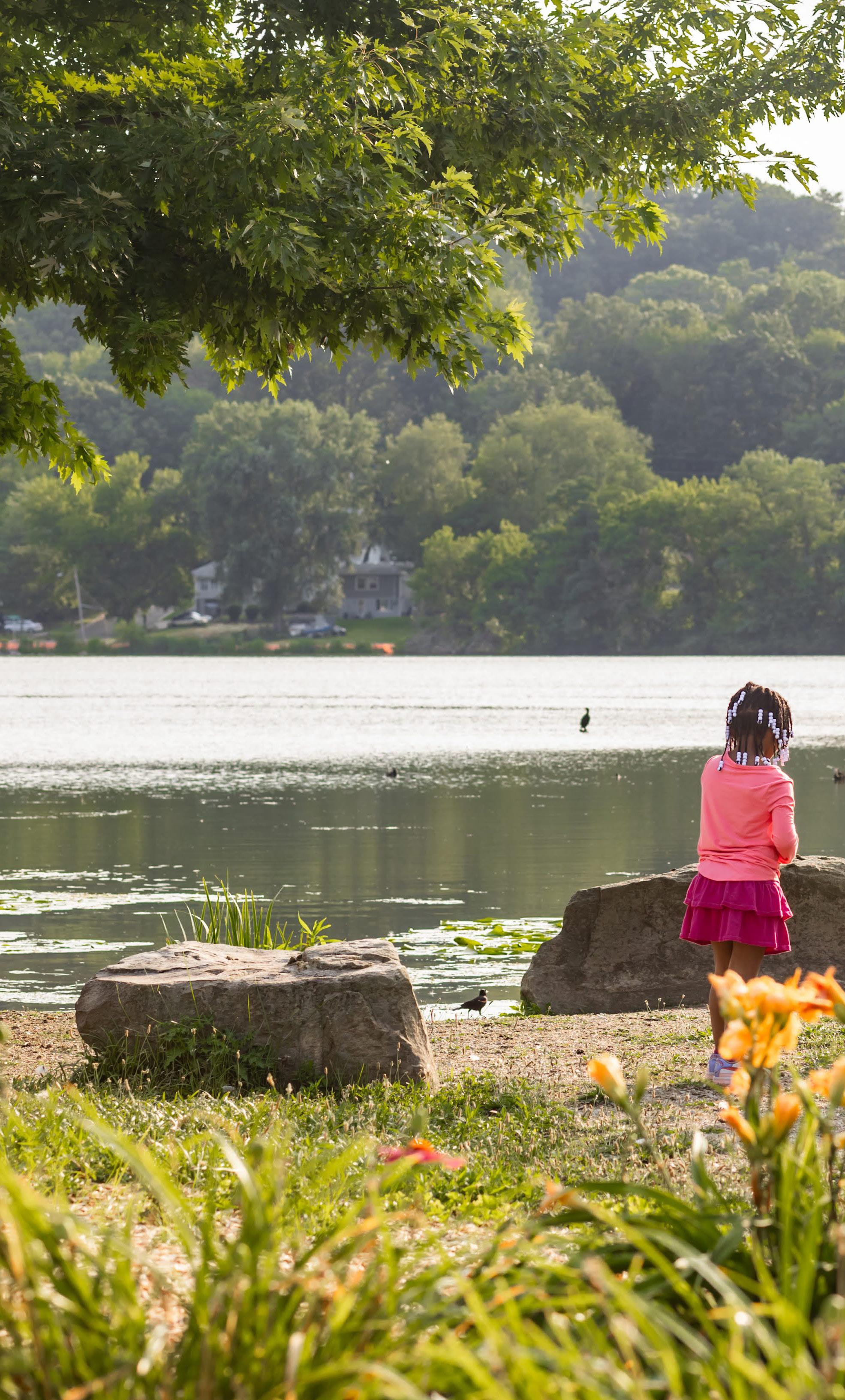
Image credit: Talia Hodge
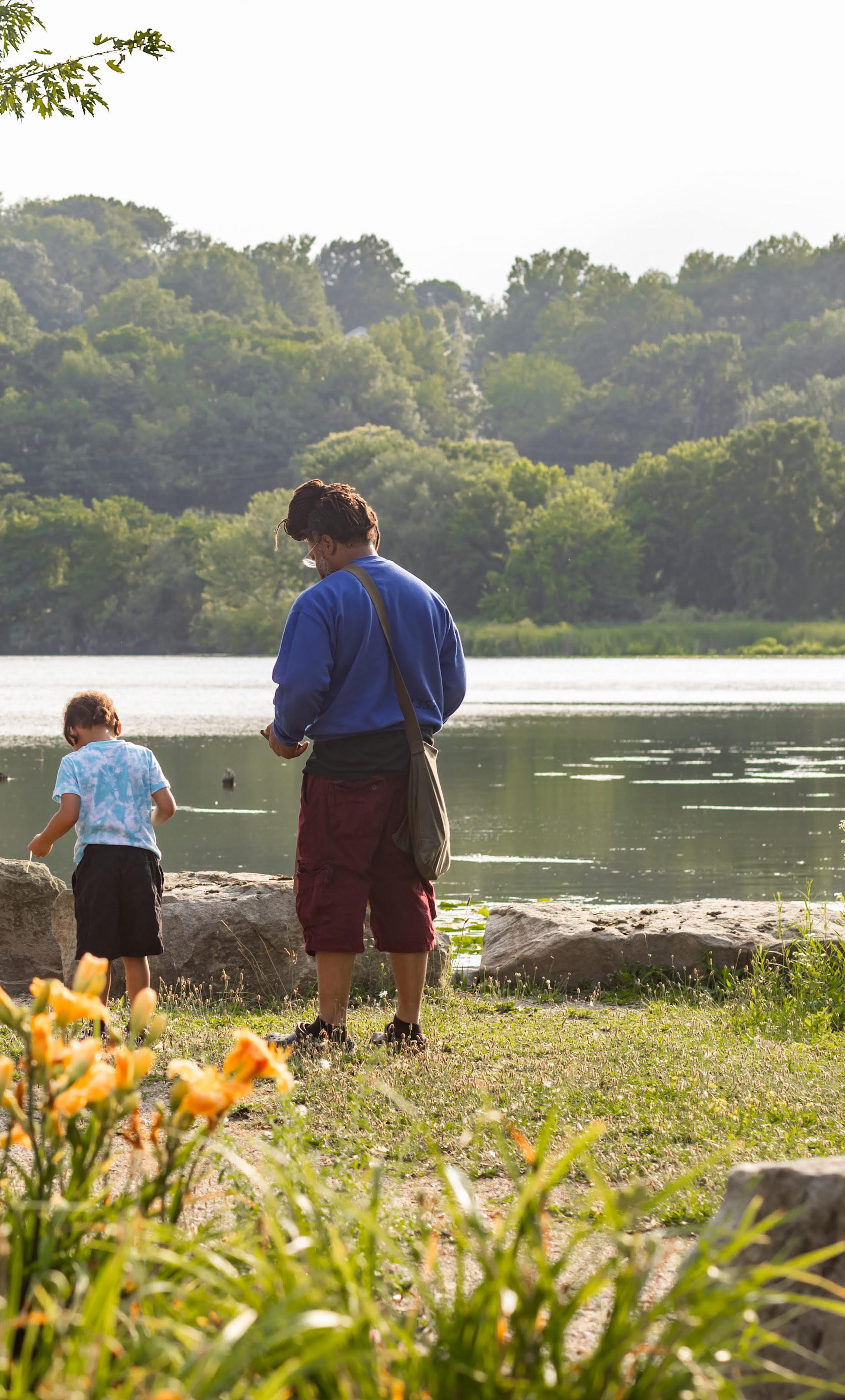
civiccommons.us | @civiccommonsus
